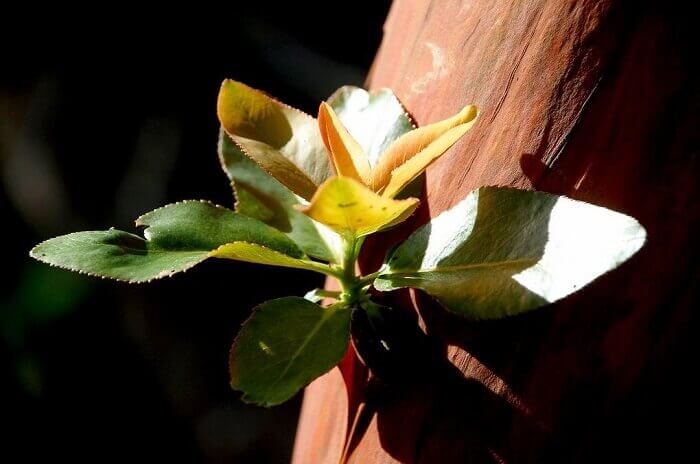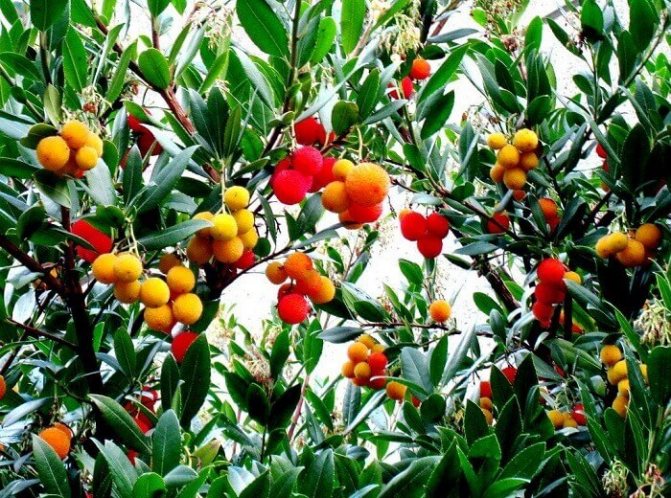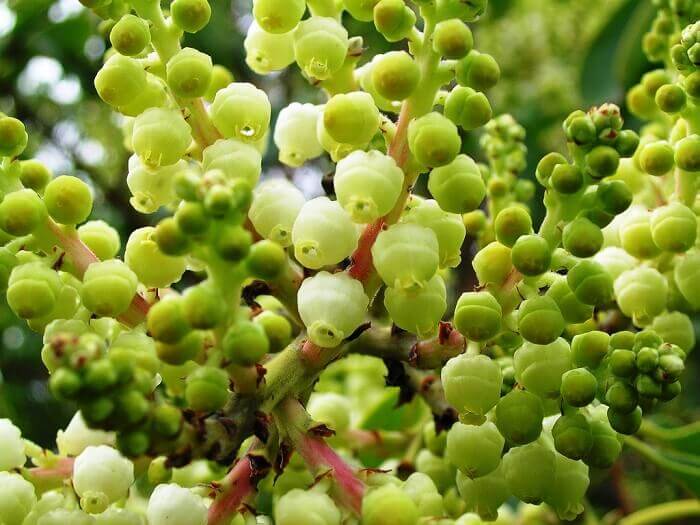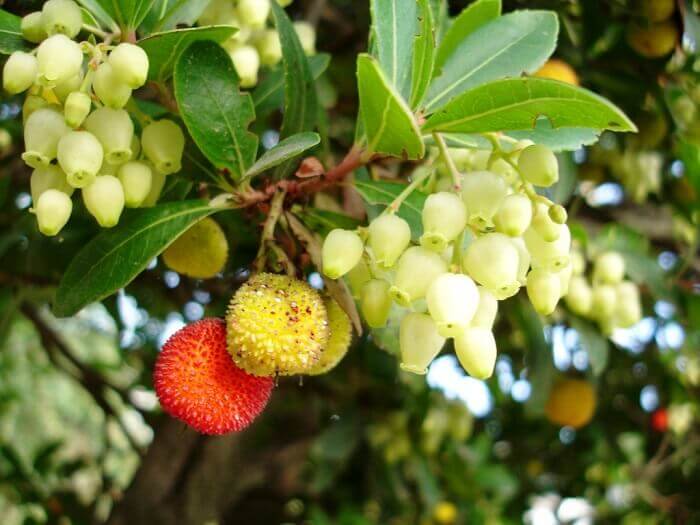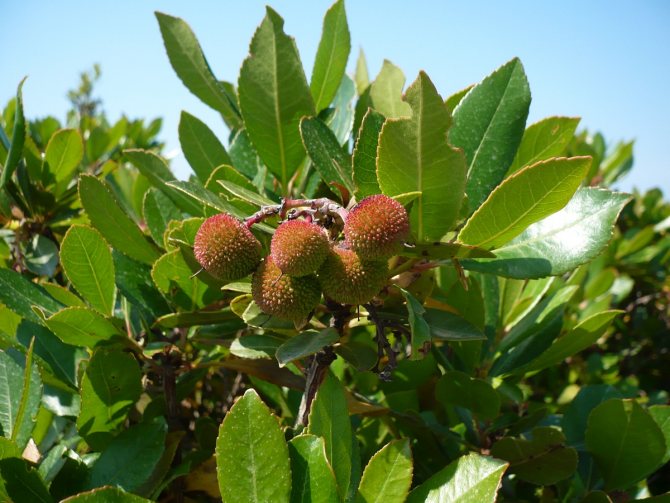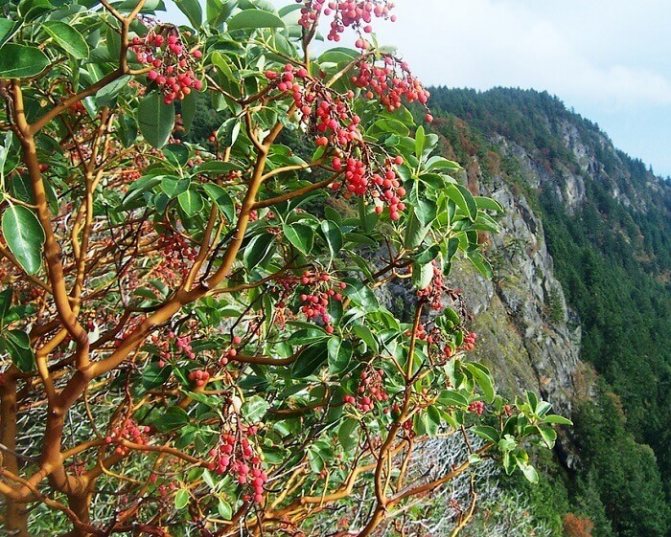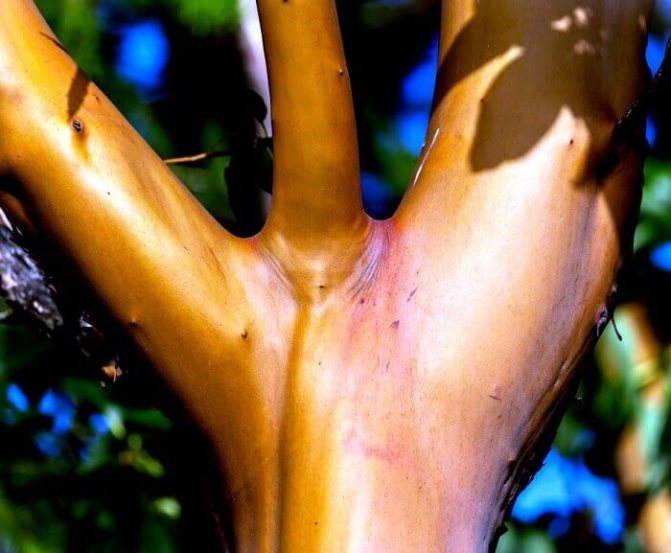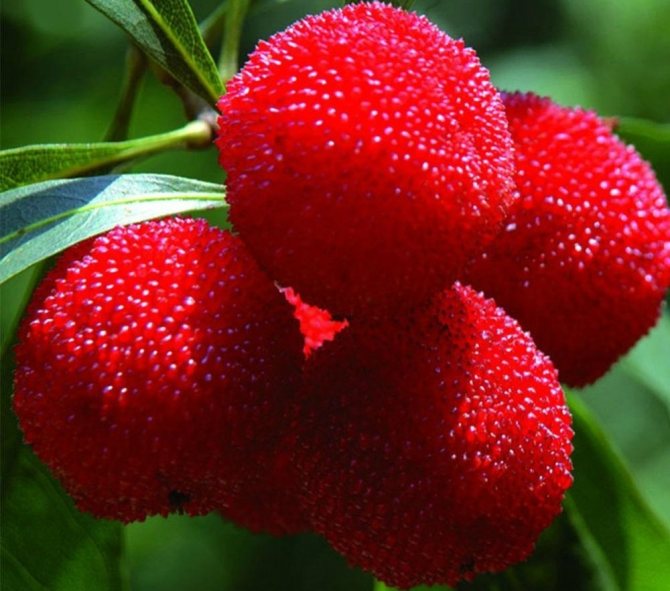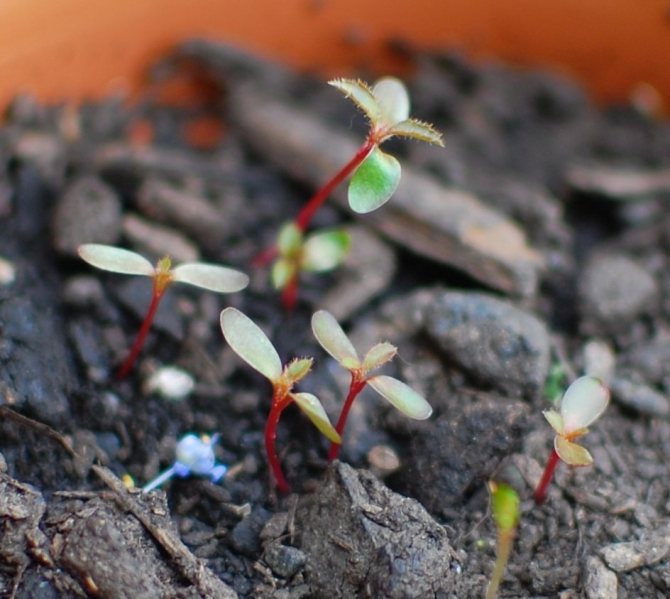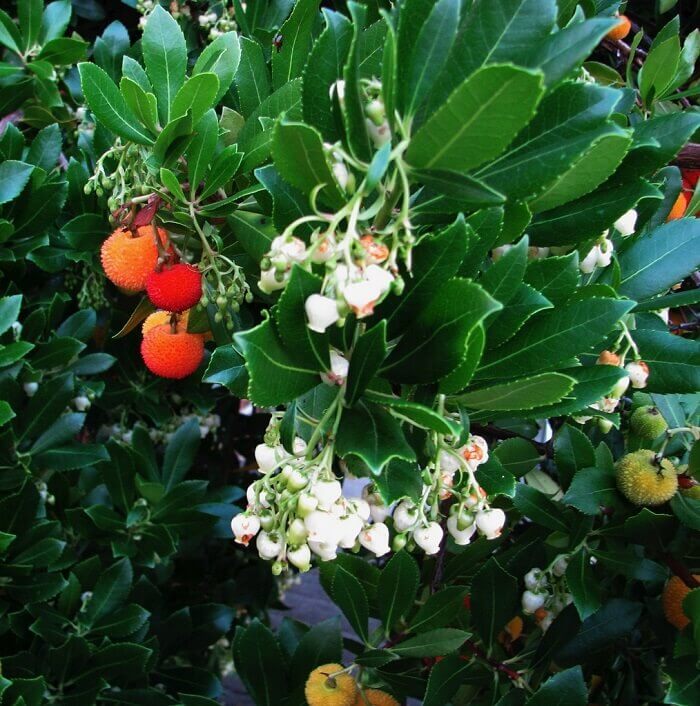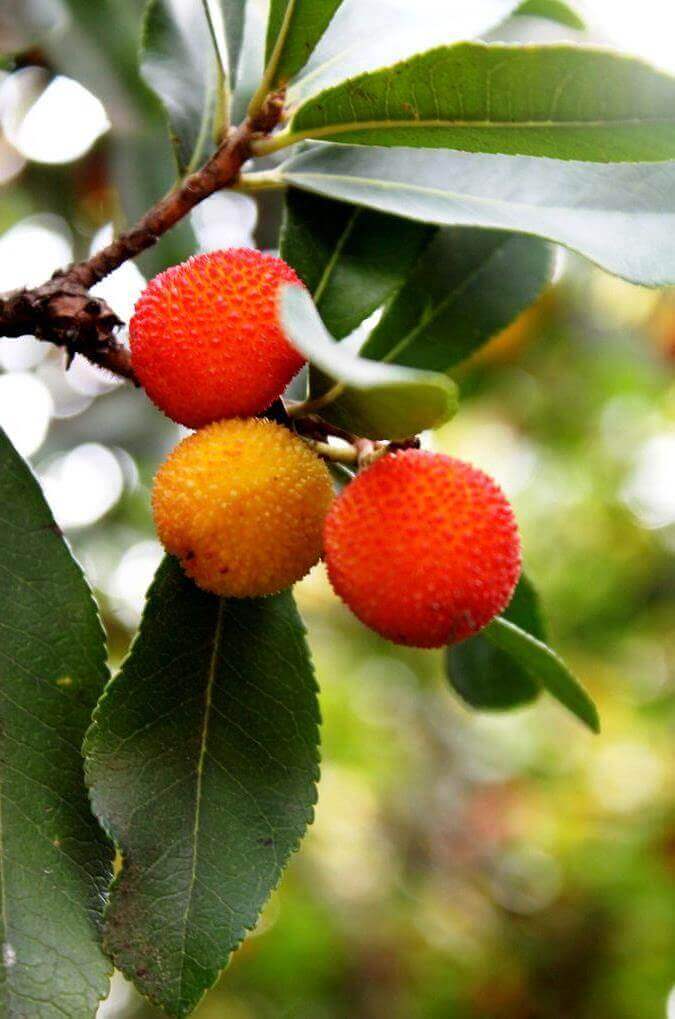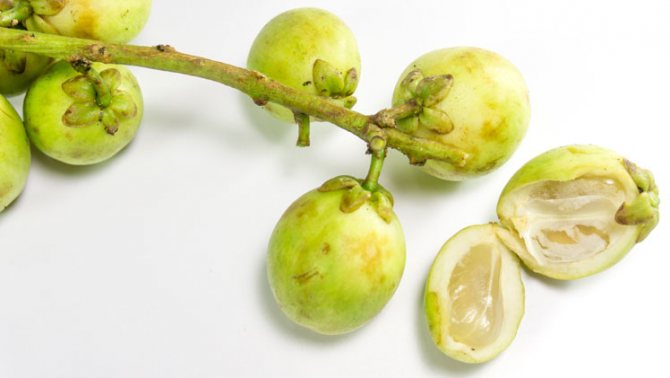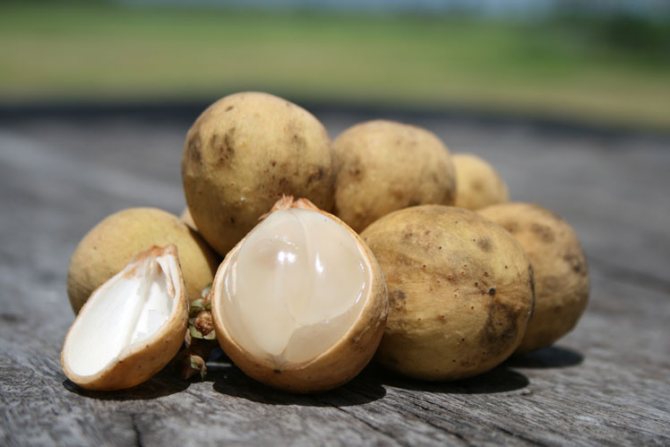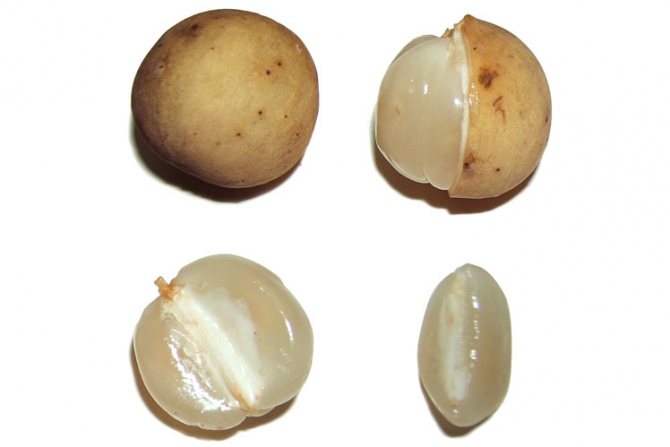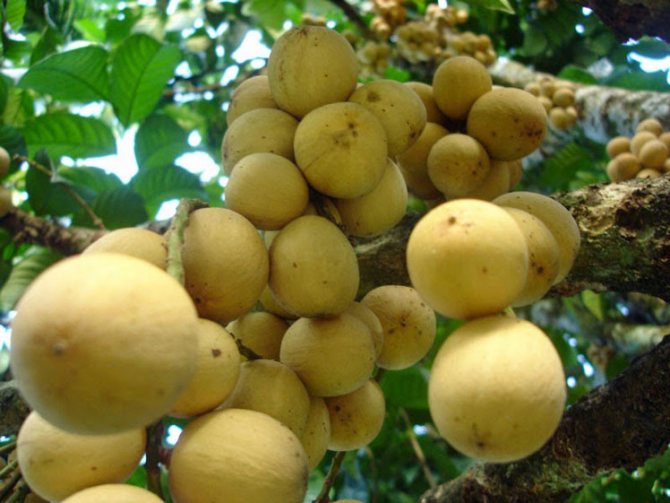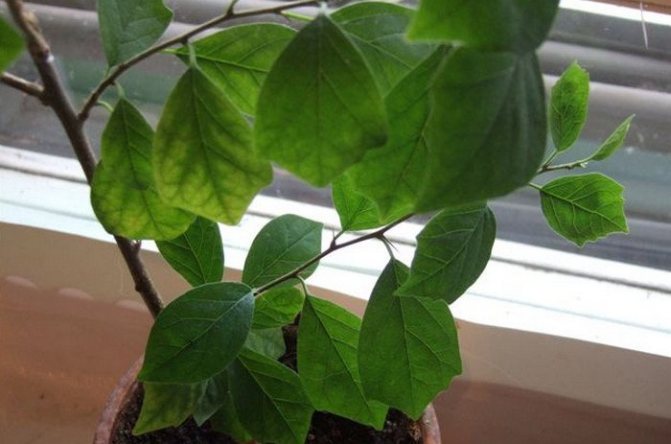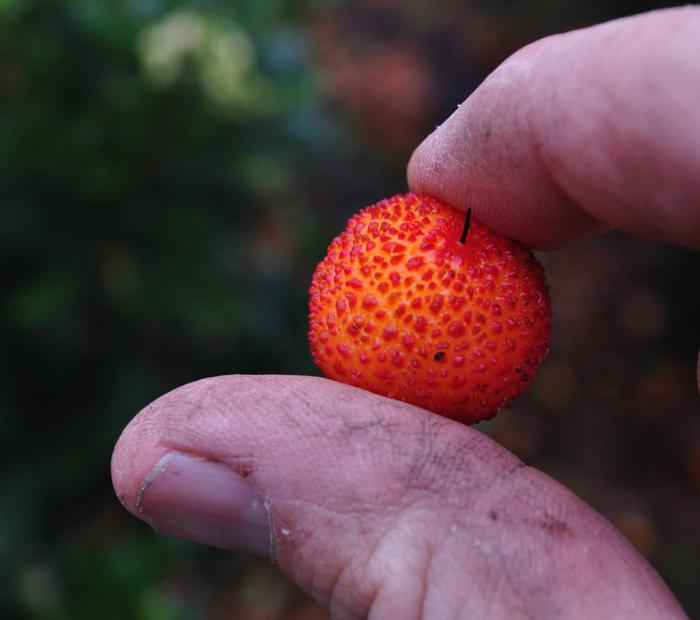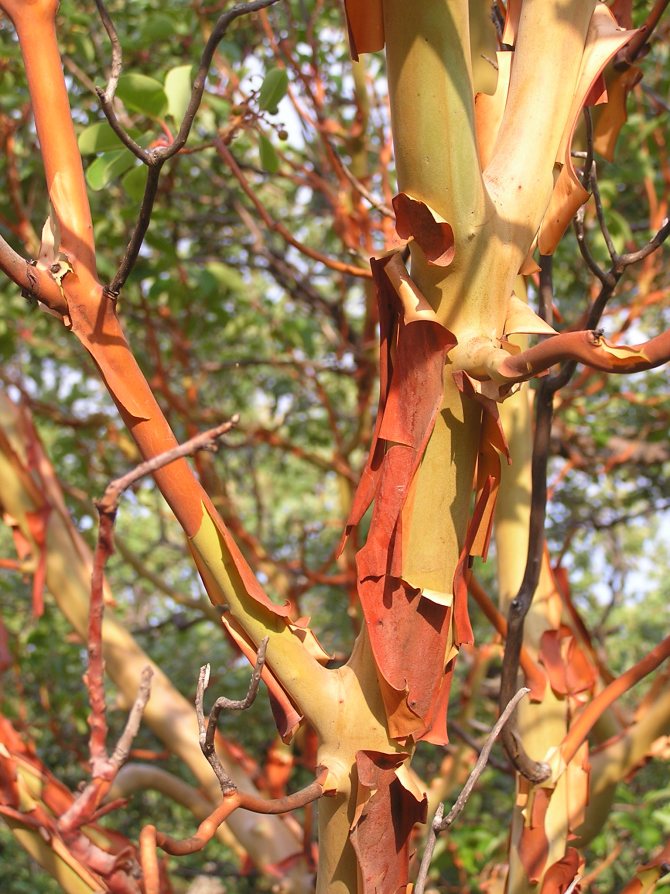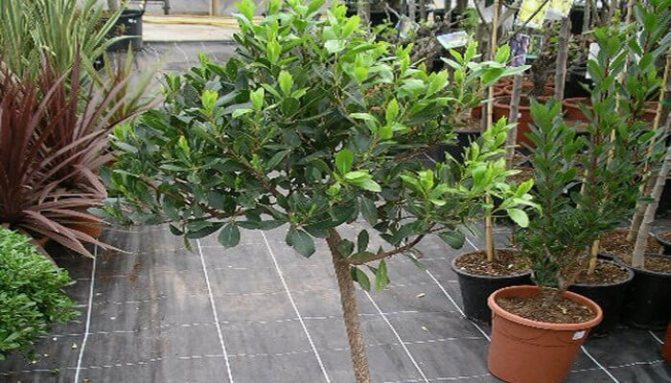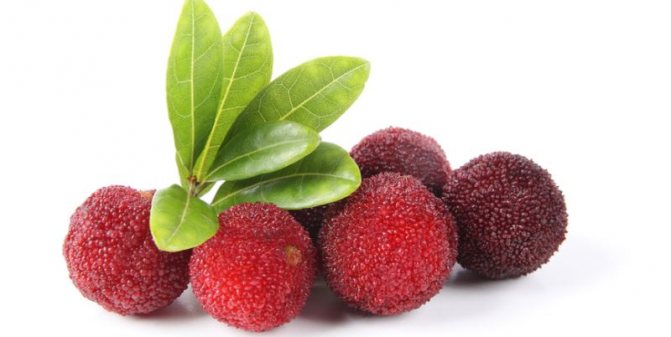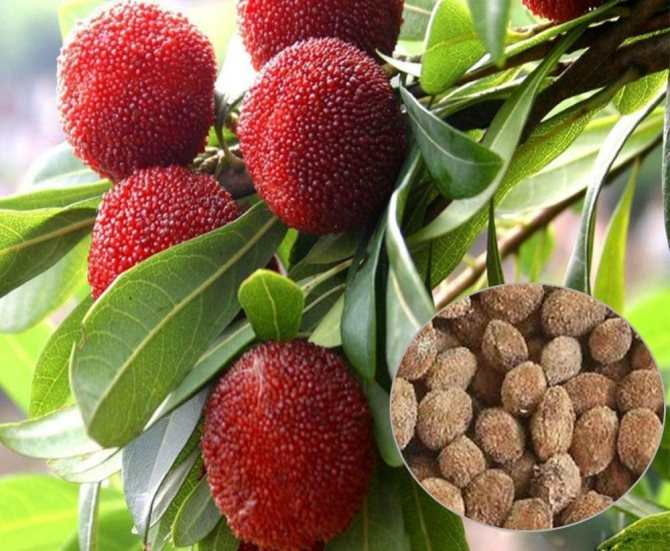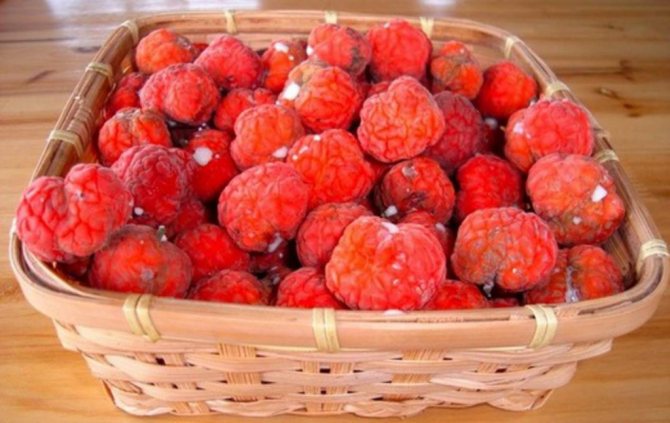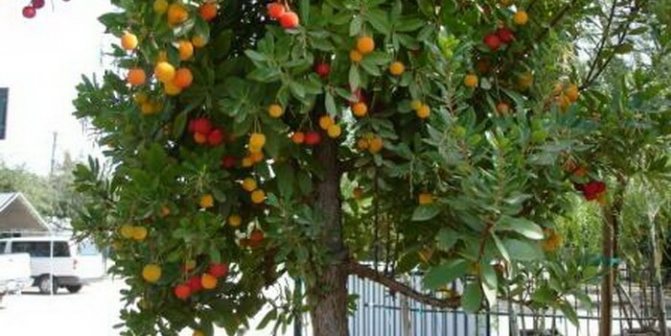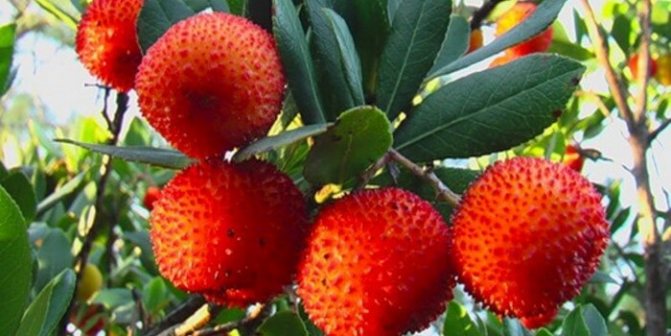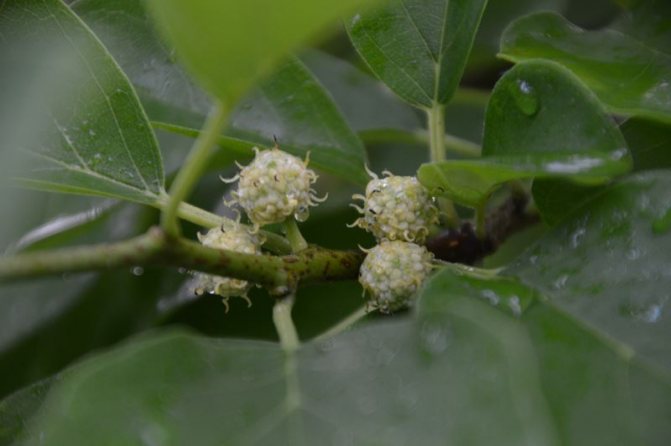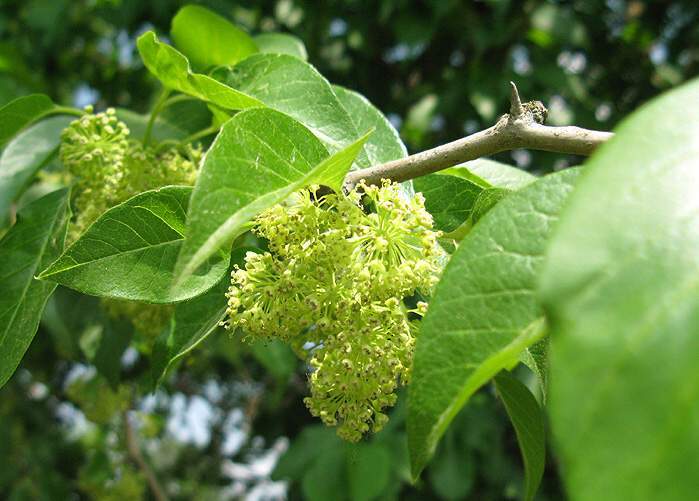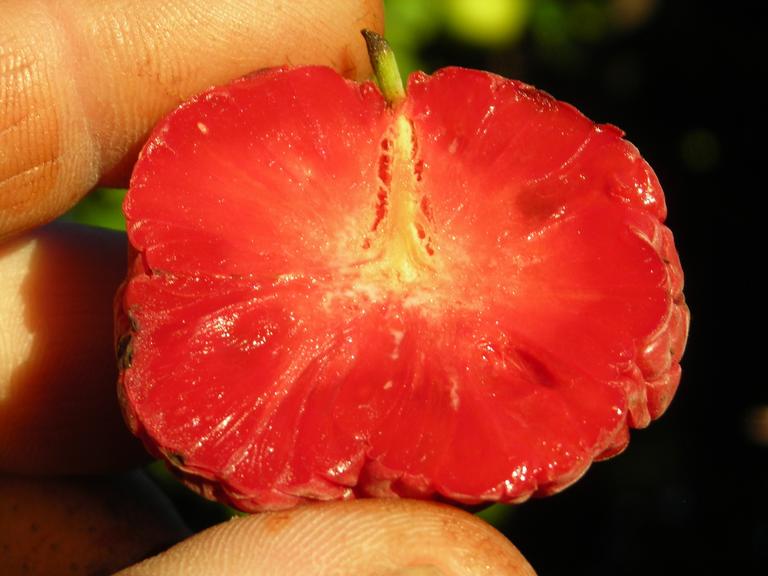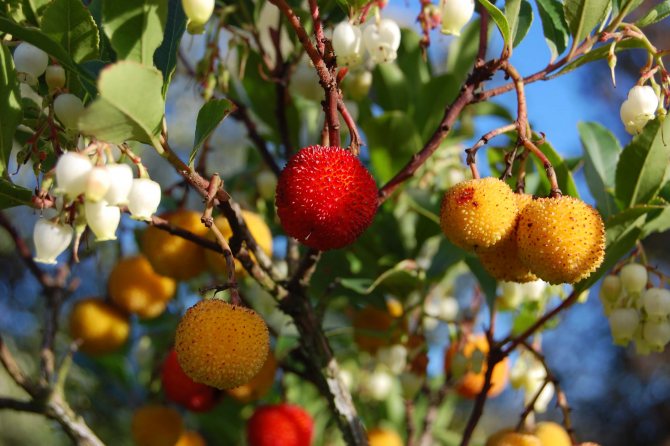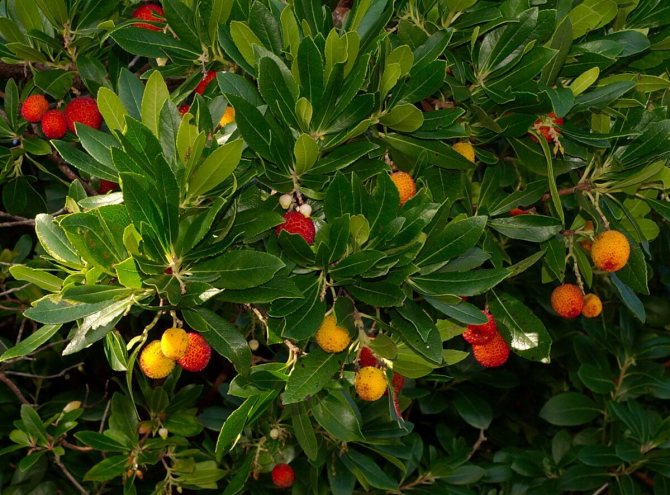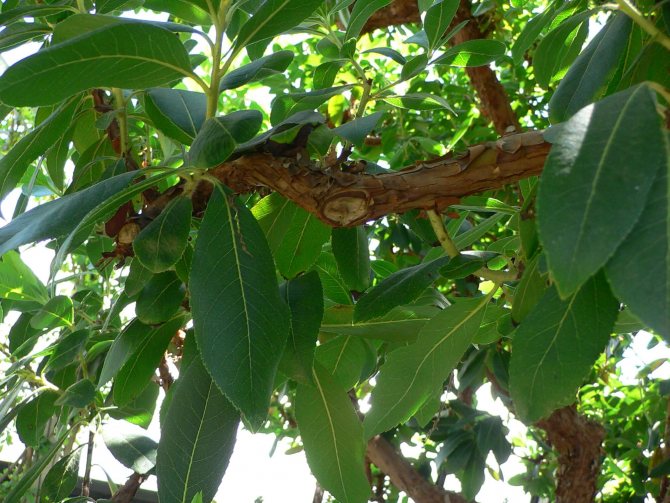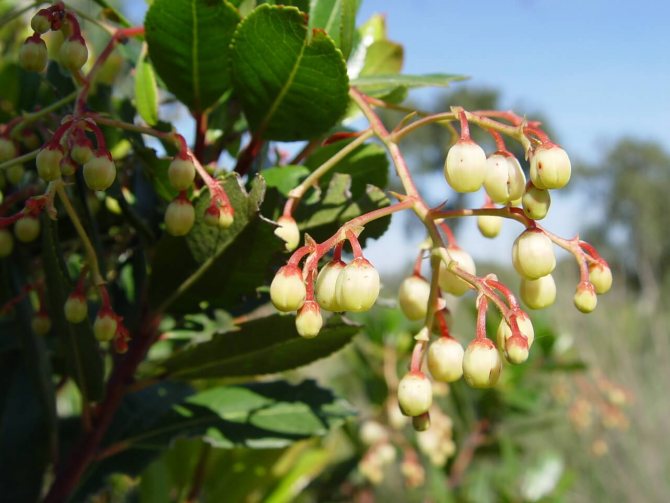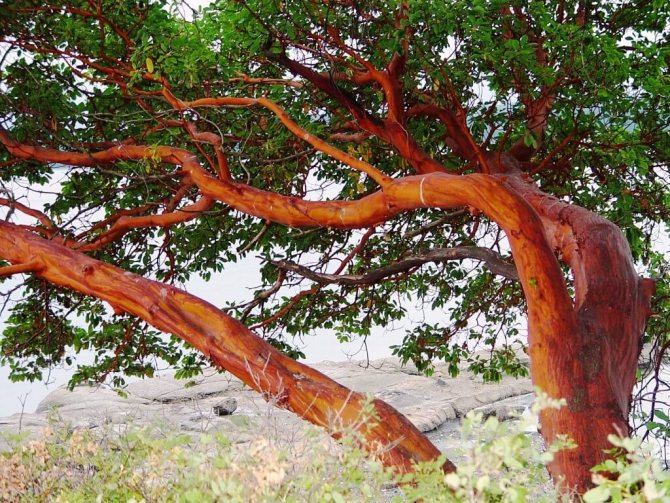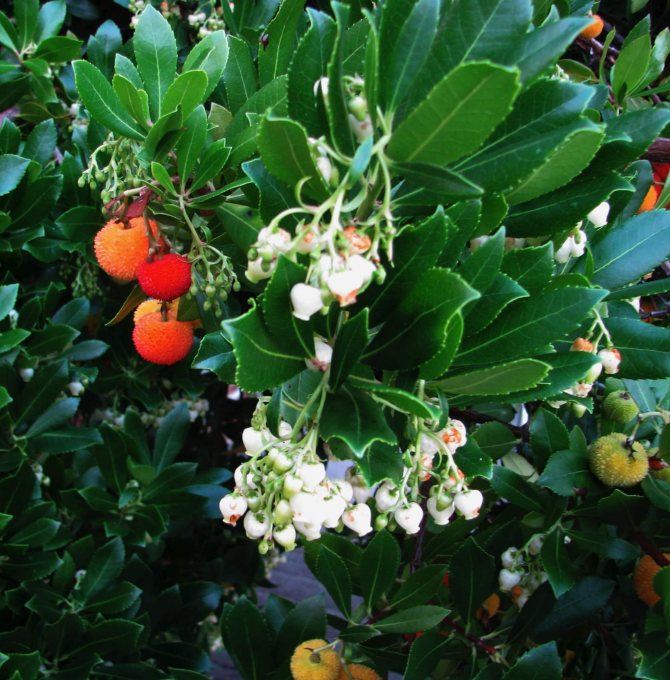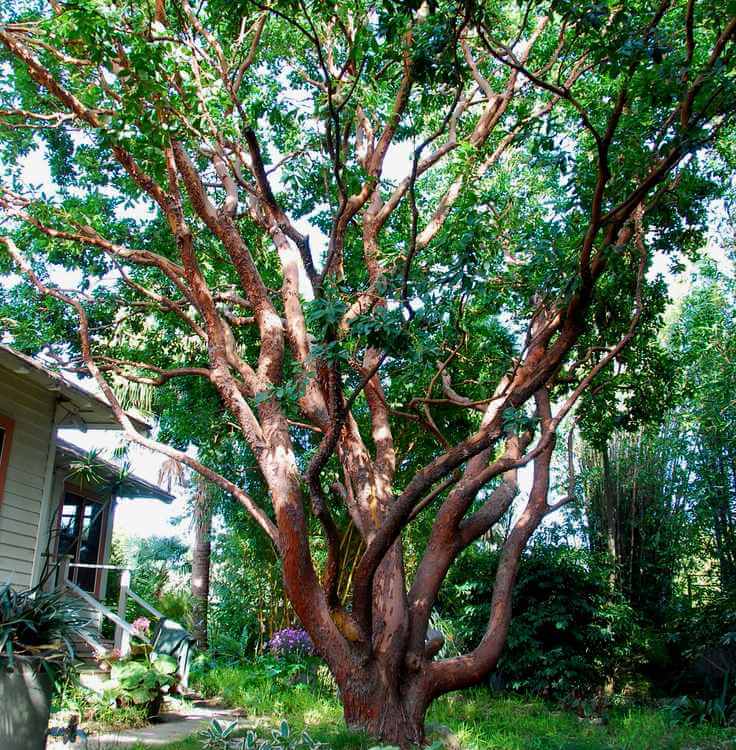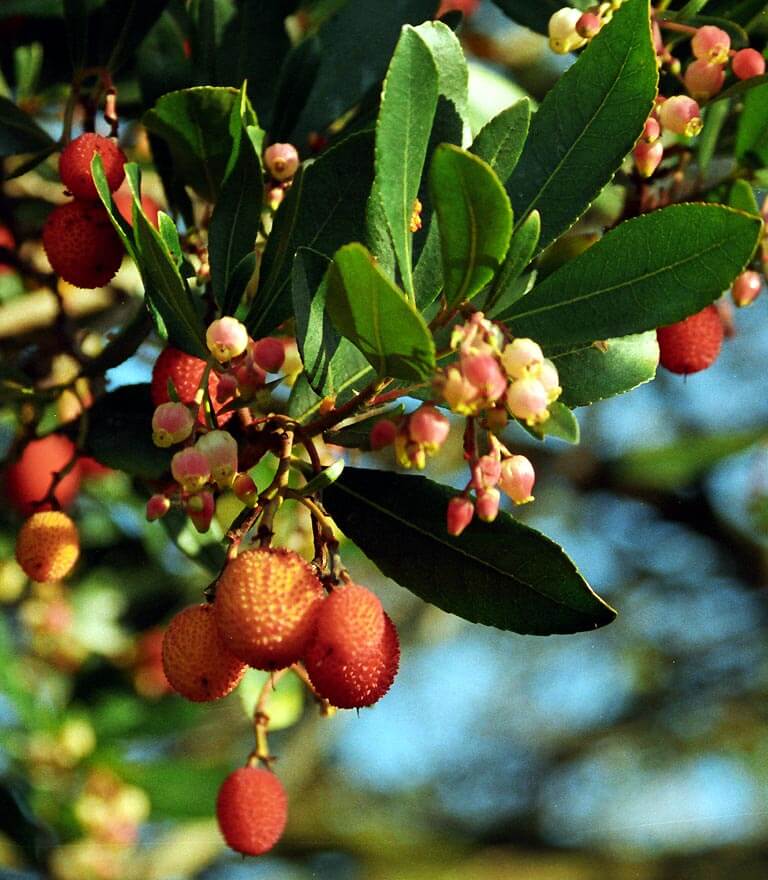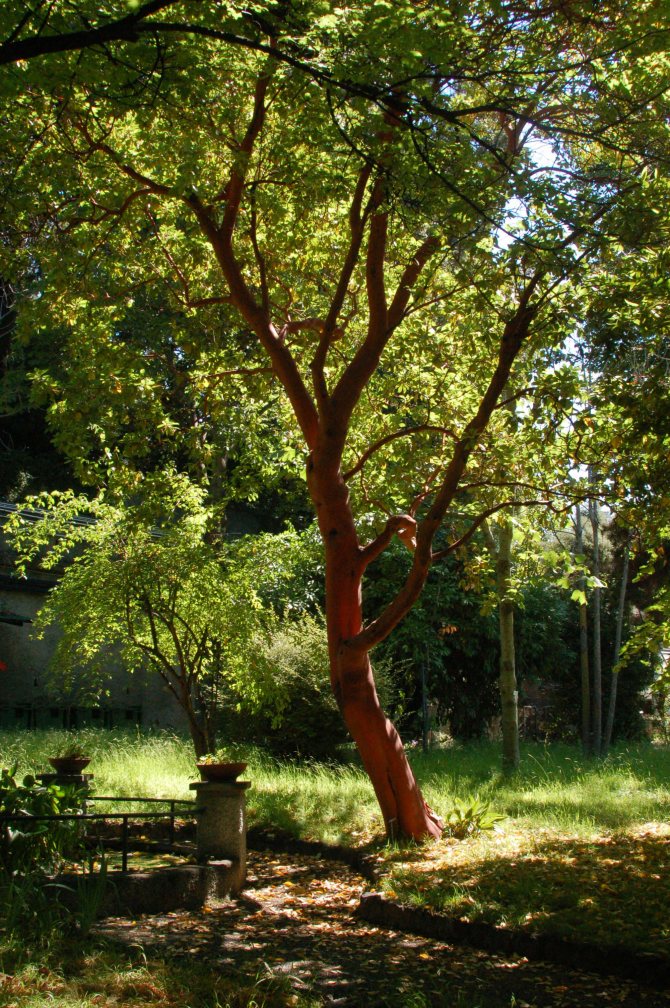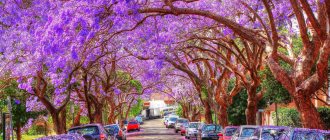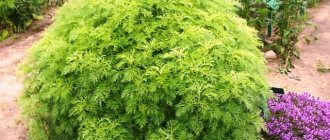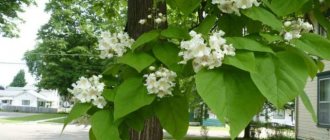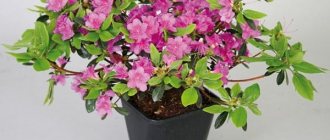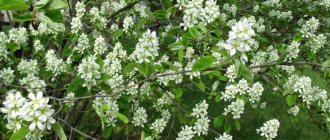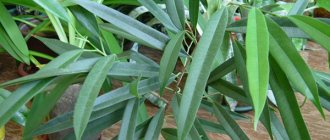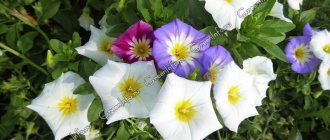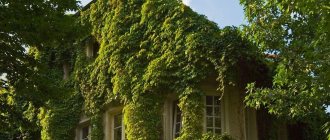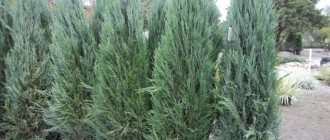Large-fruited strawberry tree or arbutus (Arbutus unedo) - is an evergreen shrub or a small tree from the Heather family.
In its natural environment, the plant is found in Morocco, Lebanon, Israel, Algeria, Asia, in the countries of the Mediterranean basin and in Western Europe. The pink-blooming subspecies A. unedo rubra was discovered in Ireland in 1835.
Culture is often mentioned in the works of poets and artists. The plant is depicted on the coat of arms of Madrid, and in the center of the city there is a sculpture of a strawberry tree and a bear, which feasts on its fruits.
Strawberry tree care is quite unpretentious and can adapt to different growing conditions. Its relative, the small-fruited strawberry (Arbutus andrachne) blooms in winter, so in the middle lane you will not see its small, strawberry-like berries.
Elderberry cultivation, species and varieties
This species is more unpretentious and can grow on poor and dry substrates.
Species diversity
About 14 species of Strawberry are well known, but the most popular are the following two:
- Arbutus unedo - Common strawberry tree. Has great fruits;
- Arbutus andrachne - Red strawberry tree, small-fruited.
For amateur breeding, the first type of plant is often chosen - large-fruited Arbutus. This species is quite thermophilic and does not tolerate frost, therefore, in our latitudes, it can be grown only under the shelter of premises heated in winter. Best of all, the plant feels in large conservatories and greenhouses, but it is quite acceptable to breed it in an apartment or a residential building.
In the latter case, the unusual beauty of Strawberries is especially appreciated. Its branches create an intricate structure, bizarre crowns covered with foliage with a noticeable emerald tint, and at the moment of flowering, the Arbutus of the Rubra species is especially beautiful.
Quote from galkapogonina WONDER-WOOD. Strawberry and strawberry trees
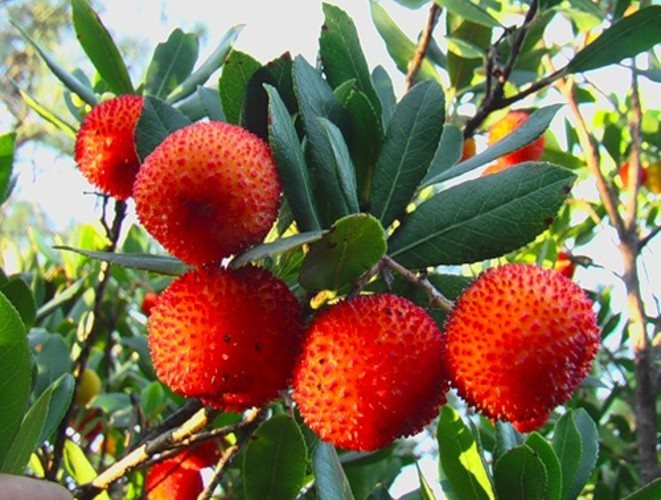
The strawberry tree is a genus of shrubs or trees of the Heather family. The strawberry tree is another tasty tree. Its fruits outwardly really resemble strawberries - bright red with a small tuberous surface. The fruit of the strawberry tree is edible, juicy and sweet. Jam, wine and liqueurs are made from them. The botanical name for the strawberry tree is large-fruited strawberry (Arbutus unedo). This evergreen plant belongs to the heather family and lives in the wild on the shores of the Mediterranean Sea. Unlike a low heather shrub, strawberry is a real tree. Its leaves are oval, dense, shiny. The flowers resemble blueberry flowers - small "lanterns" collected in bunches. Strawberry is a very decorative tree, it is grown in many botanical gardens and parks around the world. In our country, it can be found in the south, in seaside parks and botanical gardens. And the closest relative of the large-fruited strawberry, the small-fruited strawberry (Arbutus andrachne), is found in the wild on the Black Sea coast of the Caucasus and on the southern coast of Crimea. This is perhaps an even more elegant tree. The trunk and branches of the small-fruited strawberry are covered with bright orange-red bark. This plant is also interesting in that it sheds the outer layers of its bark every year.The young bark is greenish at first, but over time it “tans” - acquires a red color. For this feature, the tree is also called a health resort or shameless woman. In all other respects, the small-fruited strawberry is similar to its large-fruited relative. It is also an evergreen with red edible fruits. There is another "strawberry tree" - red myrica (Myrica rubra) from the myrtle family. This tree, 5-15 m high, grows in Japan, China and Indochina, where it was introduced into cultivation as a food and medicinal plant. Mirika fruits also resemble strawberries in appearance and taste - medium-sized, spherical in shape, with a dense leathery shell and tender, sweet pulp. Tannins and dyes are extracted from the bark of the mirika. —————————————— Strawberry tree Strawberry tree - Arbutus andrachne - קטלב מצוי (ktalav) Ancient Latin name of the genus - Arbutus. The etymology is not clear. Perhaps from lat. arbor - tree and suffix. ut, us (at, us), meaning a species concept. The name of the species is Andrdchne, Andrakhne. Perhaps the name goes back to the Greek. andros - man, husband, warrior; male. In Crimea and Asia Minor, another species of this type is called "kizyl-agach", that is, "mahogany". The strawberry tree (Arbutus) is a genus of evergreen trees and shrubs of the heather family (Ericaceae). There are over 20 types. Distributed in Western Europe, Mediterranean, North and Central America, Western Asia. In Israel, it is found in the Upper Galilee, on the Carmel and in the Judean Mountains. Loves rocky or limestone soils. In our latitudes, it blooms in March-April. These decorative and melliferous plants have leathery, simple, whole, large dark green leaves and small flowers, collected in apical panicles. Drooping inflorescences of white or pink flowers of the strawberry tree soon replace fruits that have a bright orange color. The fruit of the strawberry tree is a berry-like, multi-seeded drupe, similar in appearance to strawberries (but it is useless to compete with strawberries in taste). For the similarity of fruits with strawberries, this plant is also called "strawberry". The plant is dioecious, but pollination is only possible between two different trees. The seeds are distributed by animals. Young tree on the background of the mountain limestone. The strawberry tree is known for its rotting wood. Thanks to this, in the past, more than other trees were used for the manufacture of plows, handles, for roofing. Because of this, in our time, the strawberry tree has disappeared from many places of its growth. After the establishment of nature reserves in the Mediterranean and the decrease in felling, the number of trees increases. A remarkable beauty tree, which you can always distinguish in the forest from others by the color of the bark. The strawberry tree is one of the most beautiful trees on the planet. Picturesque is its low-stemmed trunk with several articulated-curved branches supporting a hemispherical crown with shiny emerald foliage. Smooth, like parchment, the bark is painted in an elegant dark purple color. In the middle of summer, the top layer of the bark begins to peel off and fall off in the form of twisted scrolls and thin patches, exposing a young pale green tissue. Then the new crust undergoes a series of colorful transformations and gradually, by the next summer, regains its usual dark red color. So it tries to embrace Mount Meron :) photo ilanka_n The upper, thin outer layer of the bark changes every year. Trees shedding bark are popularly called "shameless". It is interesting that during the dumping of bark in places of congestion of trees, a soft crackle and rustle is constantly heard, for which in America strawberry trees are called "whisperers". The shedding of the bark is explained by the struggle of trees living in humid climates with epiphytic plants that try to settle on the bark or in the crevices of the tree bark. Each year, freeing itself from the bark, the tree prevents the epiphytes from rooting.This tree has an interesting flower (top view) - like transparent windows. Photo https: // The insect crawls inside the flower and, after eating, tries to get out - but it didn't work, a very narrow entrance does not give, and then the insect sees the light above and tries to get out there, and again it does not work. So it spins until it finds a way out, while collecting a lot of pollen, which it will carry with it to another flower. The strawberry tree serves as a food plant for the Charaxes jasius butterfly - נימפית הקטלב (the Hebrew name for the butterfly includes the name of the ktalav tree). This is the largest Israeli butterfly. She lays eggs on the Strawberry tree and her caterpillars hatch there. Using. In the past, wood was used to make logs, tannins were extracted from leaves and bark, which were used in the manufacture of leather. From the leaves and roots of this tree, tannin-rich active ingredients with astringent and antiseptic properties are obtained. The fruits of the tree are edible and sweet in taste, they are used to prepare jams, liqueurs and wines. In Portugal, a fragrant vodka made from the fruit of the strawberry tree is produced - "Aguardente de Medroña". Also produced are jewelry and watch boxes made from the wood of this tree. In places where the strawberry tree does not grow, it is bred as a garden ornamental, sometimes even indoor, plant.
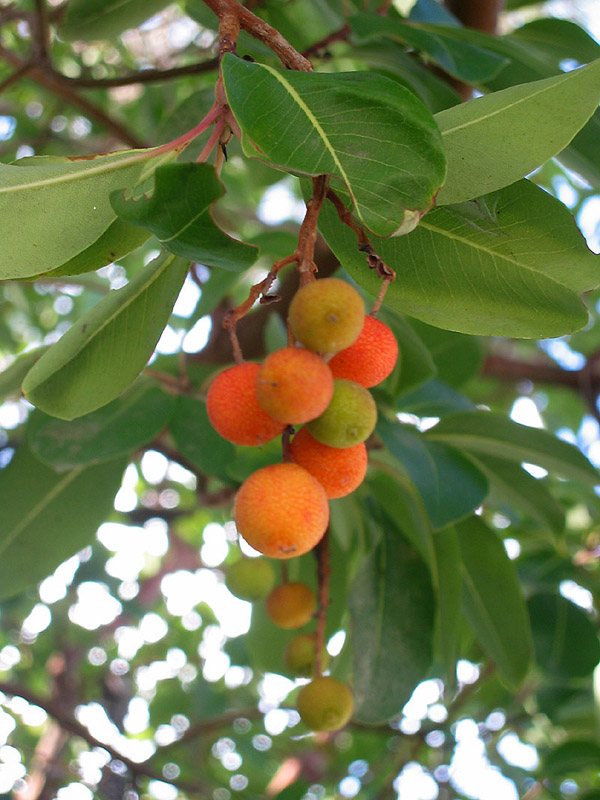

photo ilanka_n Historical information. Lived between 372 and 287 BC. the ancient Greek scientist and philosopher Theophrastus, who is called the "father of botany", expounded his teaching in written works (Historia Plantarum and De causis Plantarum). His texts mention 550 plant species, including the arbutus (Arbutus unedo). Fossilized remains of strawberry trees were found 5 km from Petra (Jordan). This indicates that the climate in these parts was cooler and more humid. The bronze bear by the strawberry tree is the symbol of the city of Madrid. The patriots of Madrid claim that there used to be a grove of evergreen trees, whose fruits taste like strawberries, and many bears roamed here. The strawberry tree is part of the shrubbery of the Mediterranean coastal regions - the so-called maquis, or poppies, as the French call them. So he also has a glorious military past: he served as a shelter and refuge for the French partisans who "went to the poppies." photo ilanka_n Legends of strawberry trees
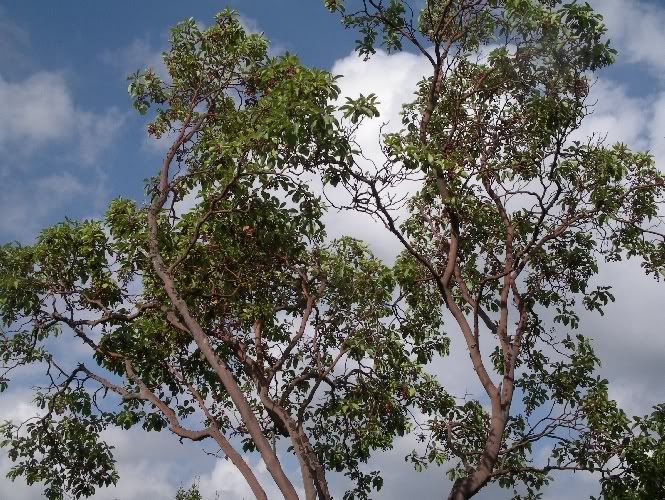

photo anno_nin Arabic folklore. Once upon a time there was a father, a son and a son's wife. Somehow the father fell seriously ill, and the son set off on a long journey for medicine. Time passes - the son does not return. Faithful Penelope is waiting for her husband and selflessly caring for his father. In short, our old man began to recover. About the son, not a rumor, not a spirit. Here they sit, while away the time in long conversations about where her husband has gone, make assumptions one more terrible than the other, and discovered such a commonality of views that they could not help but fall in love with each other. Well, time passes, the husband returns from a business trip, brings the medicine. Everyone is awfully happy with him. The father finally recovers. And then the son accidentally discovers that his wife is expecting a child. What? How? Where did it come from? She confessed everything. The husband, of course, was upset. He took an ax to restore peace of mind, and hacked dad to death. After that, he came to a final breakdown, buried the old man with all the honors, cried, of course. But on the grave, a tree red as blood still grew. And the name of the tree is ktlav - ktal av (killed his father). So that others were discouraged.
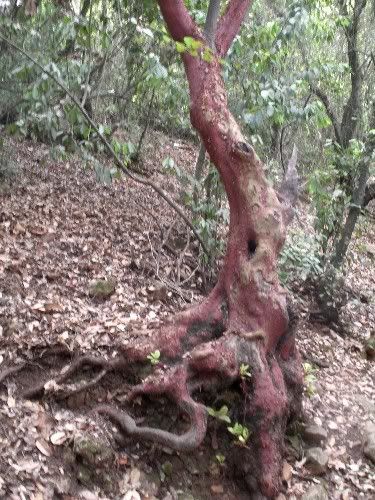

photo anno_nin Another father liked his son's bride, whom he took into his harem while his son was grazing cattle in a distant pasture. Then dad went to check on his son, told him all this, and also laughed at him. Well, the son, of course, got angry, poked his grandfather with a staff, hit the head ... then a sea of blood, accusing the trees ... In general, the scenario is similar.
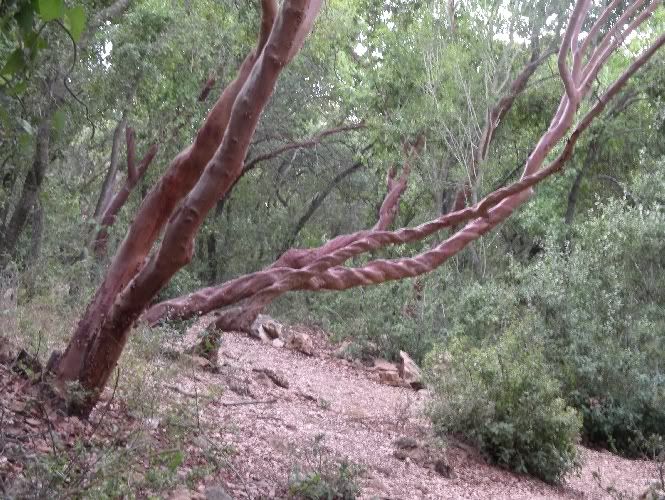

photo anno_nin And here is a fairy tale from the times of the English Mandate: Once upon a time there was a tree, and a bird sang in its branches (option: a sick bird flew in, and the tree cured it, fed it, gave it drink). The bird got tired, the bird flew away, the tree became sad and went to look for the bird. Gathered all forces, strained muscles, with difficulty pulled out knotty roots from the ground. The sun burned him, but it stubbornly moved forward, his skin peeled off, it climbed higher and higher into the mountains, but did not catch up with the bird. Tired and stopped. And he said: cut love - even the most incredible efforts will not bring love if they are one-sided. photo anno_nin Kaleidoscope. * Ideal parameters of the Harry Potter wand in one of the online games: 14 inches, olive tree, orange tree, pistachio tree, strawberry tree and phoenix feather, dragon sinew. A little bent. * In the language of flowers, Arbitus (strawberry tree) means - I love only you. * One of the species of the genus of strawberry trees growing in the Canaries is called the Canary strawberry tree, or the golden apple of the Hesperides. Blooming strawberry tree. In the fall, the strawberry tree is covered with red globular fruits the size of a small apple, shaped like giant strawberries. They are edible and consist of a sweet slimy pulp in which rather large "grains" are immersed. But, of course, the fruits, or rather the fruit of the strawberry tree, have nothing to do with real strawberries. The scientific name of this plant is Cornus capitata, and it belongs to the dogwood family, while strawberries and strawberries are known to belong to the Rosaceae family. In the wild, the strawberry tree grows in the Himalayas and in southern central China.
Plant care rules
At home, this plant is grown mainly in flowerpots or pots. At the same time, it is especially carefully protected from frost. It is best to grow a tree from a ready-made seedling, but you can use a cuttings and even plant and germinate the seed of a ripe fruit.
Landing
Planting a strawberry tree from seeds provides for a certain sequence of actions:
- A nutrient substrate is prepared. It should include 70% of peat, preferably high-moor and 30% of washed river sand. In this composition, after slightly moistening it for 2 months, the seeds are stratified. They must be harvested from a ripe fruit;
- After stratification, the seeds are soaked in water at room temperature for 7 days and planted in the ground to a depth of about one and a half centimeters;
- A pot with planted seeds is placed in a shaded, warm place and wait for the sowing to germinate;
- When seedlings appear, as a rule, this happens around the third month, they are regularly watered with settled water, and upon reaching sufficient growth, the seedlings can be separated and planted in separate flowerpots.
If the surrounding air is dry, it is worth spraying regularly during the growth of the seedlings. At the same time, you need to ensure that excess moisture does not get into the ground. It is best to cover it with polyethylene or in any other way during spraying.
A feature of the plant can be called its unpretentiousness to the quality of the soil. The strawberry tree grows well in both acidic and alkaline environments, loose or dense, but it is still better to provide adequate drainage. The soil from the store is perfect, with characteristics - universal.
Care
Due to the unpretentiousness of the plant, caring for it is also simple. For normal health, the tree is enough:
- Monitor regular watering;
- Feed the plant as it grows;
- Provide favorable conditions for the Sheptun's wintering.
The first two points are especially important for young, growing plants, as well as for the active growing season.Watering the strawberry tree is necessary only with settled water, at room temperature, and the best top dressing is high-moor peat.
This plant is quite light-requiring, so it is worth providing it with good lighting. In the summer, it will be better to take the strawberry out into the open air and place it in a place where the sun's rays will fall on it, preferably slightly scattered. At the same time, the optimal summer temperature for the plant is 22 - 26 ° С. It is also advisable to limit the plant from strong winds, and especially from cold drafts. In the conditions of an apartment, the best summer accommodation will be a glazed balcony facing southwest.
For the winter months, after the plant has stopped bearing fruit, it should create calm conditions:
- Trim the crown. Remove damaged, weak and diseased branches and foliage;
- Transfer to a cool but bright place. The desired wintering temperature is 5-8 degrees plus, but nothing will happen to the plant even at temperatures ranging from +2 to +10 degrees;
- Limit watering to the full minimum. In this case, you need to ensure that the soil is not completely dry - it is worth maintaining its low moisture content.
If the temperature is not lowered for the winter, the plant will be depleted and will not give color, and therefore fruit, in the warm season.
Nutrient feeding
As a rule, a strawberry tree growing in a greenhouse is fertilized with manure or compost, 2 times in the spring and summer seasons, and for a plant contained in a flowerpot, a ready-made complex fertilizer from a store is better suited.
With insufficient growth activity, flowering and in the case of weak fruiting, stimulating preparations based on nitrogen and potassium can be used.
Important!
A strawberry tree cannot be fertilized for the winter, much less stimulating procedures. The effect will be the opposite - instead of dormancy, the tree will actively develop and by spring it will be severely depleted, it may even die.
Plant characteristic
An unusual plant with an exotic name kudrania is popularly called a strawberry tree for fruits similar in color and shape to strawberries, or garden strawberries.
Origin
Kudrania is a tree-like plant of the Mulberry family. Its homeland is East Asia, and now the strawberry tree can be found everywhere in Afghanistan and Iran. It also takes root well in Greece, Turkey, China, southern Russia, warm regions of Ukraine, Belarus - in any countries with a subtropical climate or in any conditions where such a climate can be created and maintained throughout the year.
Did you know? The leaves of the strawberry tree in East Asia are fed to the silkworm on farms (for example, if the leaves of the silkworm are not there or you need to replace them with something).
On average, kudrania lives up to 50 years and can reach a maximum height of 6 meters. Fruiting practically until the end of the plant's life cycle, starting from the first year of planting. Reproduction takes place in three ways: cuttings, seeds, seedlings.
Species affiliation
Cudrania tricuspidata is a tree. It is perennial, deciduous, can grow up to 3 meters or more in height. In appearance, a strawberry tree may not differ from a large bush - it depends on how the crown is formed. This plant can be cultivated both on the ground and at home, for example, on a balcony or loggia. In the latter case, the bush will be smaller, and its trunk will be lighter than that of its counterparts growing on the ground. The plant is dioecious, that is, both female and male flowers are present on the inflorescences. It blooms in May - June, depending on weather conditions and the amount of heat. Poorly tolerates strong humidity and dampness, loves sunlight and perishes in frozen ground.
Structural features
With enough space and light, a strawberry tree forms a dark brown trunk with branches on which fruits and leaves are located.The photo of the plant shows that when pruning branches, a bush can also be formed (depending on how much space the gardener will allocate for this crop). The shape of the tree does not affect the level of fruiting. Thanks to its "tenacious" branches, this plant is used for landscaping parks, creating hedges.
We recommend reading our e-magazine about growing strawberries.
Description of fruits
The fruits of kudraniya outwardly resemble strawberries, raspberries, and strawberries at once. They are round, with many seeds, in appearance they look like the fruits of the mulberry, familiar to everyone from childhood, only larger. The taste of such berries is sweet, similar to the taste of persimmons. The pulp of the fruit is firm. The cut fruit of the curl. They are used mainly for fresh consumption, for making compotes, pies, and jam. The color of the berries varies from red to maroon, the diameter is from 2 cm to 5 cm, inside the fruit there are small brown edible seeds.
Important! After picking, the berries are not suitable for storage for longer than a day - they lose their medicinal qualities and even color. That is why the fruits of kudraniya are eaten fresh or immediately added to sweet pastries as a filling.
Spread
Centuries ago, and now, the strawberry kudrania tree is grown in China, Korea, Nepal, Afghanistan, Iran, the southern regions of Russia, in the mountainous regions of Ukraine, as well as in other countries - not massively, but rather for the sake of decorating plots or as an unusual element in the garden ...
Problems
The strawberry tree is unpretentious to the conditions and is not very susceptible to diseases, but sometimes they still appear:
- Regular overflow can lead to the formation of fungus on the foliage - it becomes covered with brown or brown spots;
- Of the pests, the spider mite is most often detected, affecting the bark of the plant.
For the most part, the Strawberry tree suffers from frost in early spring, when it is taken out into the open air, and frosts occur at night. The tree is very thermophilic, this must be taken into account.
Application
Berries are consumed fresh, and also used to prepare desserts and alcoholic beverages. Store dried and frozen. The shelf life of dried fruits when stored at room temperature is 1-2 years. For longer storage, the berries are placed in an airtight container. 100 g of fruit contains 28 kcal.
All parts of this plant are used in medicine and pharmacology. The flowers are used to make diaphoretic remedies. Leaves, roots and bark are used for diseases of the genitourinary system. The extract from the bark is used for tanning leather, and is also used as a brown dye. Furniture, turning products, boxes, souvenirs, watch cases and much more are made of wood.
Arbutus is prized as an ornamental crop. Due to its unpretentiousness to growing conditions and attractiveness, it is an ideal plant for planting in garden plots and in city parks.
The strawberry is a good honey plant, but the honey obtained from its nectar has a bitter taste.
Properties of Arbutus fruits
The fruits of the plant are widely used not only in cooking, but also in medicine:
- The flowers of the plant have a diaphoretic effect;
- From the root system, preparations are prepared for the treatment of the genitourinary sphere;
- All parts of the plant are widely used in "folk" recipes.
In addition, arbutus also supplies components for the production of natural dyes, and the beauty of its wood allows it to be used for the manufacture of decorative elements of furniture and various handicrafts.
A strawberry tree at home can be grown from seeds. Sowing is carried out all year round.
Leaving after disembarkation
In order for young kudrania to grow well and give a sufficient amount of fruit in the future, follow the simple rules for caring for the plant after going into the ground.
In the first year after planting
Care rules in the first year:
- in the first year after planting in a nutrient earthy mixture, it is not necessary to fertilize the plant;
- provide good looseness of the soil so that the roots receive a sufficient amount of oxygen;
- in winter, in the southern regions, the tree is wrapped in natural fabric for the winter;
- straw or coniferous needles are poured on the root part for the winter;
- during the period of flower formation, fertilizer is applied to the soil in the form of humus.
Did you know? Kudrania has a rejuvenating effect - in ancient times its fruits were used as the "elixir of youth". Asian women ate the plant in question as a remedy for the beauty of hair and youthful skin.
For an adult plant
An adult plant should be looked after by following these simple steps:
- in winter, the trunk of a tree is wrapped;
- a natural protective layer (hay, coniferous needles) is laid on the root zone;
- in the second year after planting, mineral fertilizers are added to the ground (for example, "Kemira Universal" or "Bogatyr");
- the first 5 years of a tree's life, long shoots are cut in order to form a crown;
- curls need to be constantly sprayed, especially if the summer is very hot (this recommendation applies to both home and garden plants).
Growing conditions
Before sowing, the seeds are stratified for 60 days in a planting mixture consisting of high-moor peat (70%) and sand (30%), after which they are soaked in warm water for 6-7 days. Sowing is carried out in drained soil to a depth of 1.5 cm. The container with the plant is placed in a warm, shaded place. As the soil dries up, watering is carried out. The first shoots will appear in 2-3 months.
To grow a strawberry tree, you will need an earthy mixture taken from under woody plants. In the summer, the seeds are exposed to the open air, and in the winter they are kept in a cool room.
An adult plant of a strawberry tree does not need special care. Regular watering is necessary during the growing season and fruiting. During the growth period, composting is required 2 times a month. In winter, feeding is carried out once a month, but only if the tree is in a heated room. At temperatures less than 10-11 ° C, feeding is not needed.
A strawberry tree grown from seeds in indoor conditions reaches a height of no more than 1 m. Its flowering occurs in the second year after sowing and lasts from September to December.
Growing from seeds
The method is complicated and time consuming, since curdranium grown from seeds begins to bear fruit only 10 years after planting. However, if there is no goal to get a huge harvest, but you want to decorate the plot or loggia, feel free to grow a strawberry tree, because in the first year the growth of the seedling will reach 1 meter.
When to sow
It is recommended to sow curl seeds in the same period when they were removed from the fruits, that is, at the end of August. It is easy to extract them - just pick a ripe berry, crush and rinse the seeds in a sieve or on a cloth. The resulting brown grains can be planted immediately into the prepared substrate.
You will be interested in learning how to grow strawberries from seeds.
Sowing process
The seeding scheme is as follows:
- a mixture of peat, sand, perlite and humus is poured into a small pot;
- planted seeds directly in the pot are covered with a film so that it does not touch the ground;
- put the pot in the refrigerator - where vegetables and fruits are stored (bottom cell);
- after two months, the pot is transferred to the heat - the temperature in the room should not fall below + 21 ° C;
- the soil is constantly moistened.
The sprouts should appear in 1–2 months. The described plant will bear fruit after rooting in a pot and a set of leaf and root mass - only 10 years after planting.
Seedling care
Special care for curl seedlings is not required.
It is important to provide three conditions:
- constant heat - the temperature is not lower than + 21 ° С;
- soil moisture (however, it is important not to be confused with wet soil and dampness);
- spaciousness and enough sun.
Transplanting
The curls, ready for planting in the ground, can be planted after the seedlings get stronger, a trunk 20 cm long appears.
Important! Kudrania loves loose soil, so it is recommended to loosen as often as possible so that air flows to the roots.
The disembarkation process is as follows:
- prepare a hole for planting a tree (dig a hole 1 meter deep, at the bottom of which drainage is poured, at least 30 cm);
- nutrient soil is poured into the pit (peat, humus, sand and turf soil are taken in equal parts);
- the soil should be well loosened, then place the seedling, straightening the roots before planting, pour another layer of soil on top and gently crush the earth.
Strawberry tree care at home
- Location and lighting.
Place the plant in a bright place, but not in direct sunlight. The room must be ventilated. The optimal temperature regime in summer is 18-22 ° С, in winter - 8-10 ° С. In summer, the shrub can be taken out into the fresh air.
- Watering.
Watering should be regular and abundant, but without overflow. Especially watch out for sufficient moisture in the earthen coma during the period of active growth and ripening of fruits. The water should be soft, settled.
- Air humidity.
Does not need spraying.
- Soil and replanting.
Young plants are transplanted every 2 years, older ones - as needed.
- Top dressing.
Strawberry needs to be fertilized, feeding only in spring and summer with complex fertilizer 1 time in 2 weeks. In autumn and winter, at temperatures below 12 ° C, the plant is not fed. In a warm room, fertilizing is carried out once a month.
- Reproduction.
The strawberry tree propagates by seed or apical cuttings.
- Other.
The plant tolerates shaping and pruning well. Can be grown in bonsai culture.
Under natural conditions, the strawberry tree (kudrania) grows on forest and mountain slopes in East Asia, China, Afghanistan, Iran. In China, the leaves of the tree are fed to the silkworm when there are no leaves of the mulberry tree. In these places, the plant is grown not only for the sake of berries, but also for landscaping and consolidation of the soil. It prefers subtropical and tropical climates. The strawberry tree grows up to 6 m and belongs to the mulberry family. It can grow up to 50 years old. Its leaves are simple, with small notches at the edges.
Strawberry tree care at home:
- If you are growing a plant in an apartment, then place the pot on the southern windowsill.
- In summer, the strawberry tree is taken out on the balcony or buried in a pot of curls in the garden. But first you need to take the plant out to the loggia for a short time in order to accustom the plant to the sun's rays.
- Water in moderation. The tree perfectly tolerates drought, since it has powerful rhizomes, but in the heat you need to spray the tree with warm water.
- If it grows at home, it must be shaped like a low-stamped one. The crown should be low and consist of 4-5 skeletal branches, from which shoots extend. Very often, he grows strong shoots that are directed vertically or into the crown. These shoots are cut at the base.
- In the first 5 years of cultivation, it is necessary to prune the branches in the spring, and in the summer to pinch and thin out the shoots.
- By winter, the plant is moved to a cooler room, since it needs a dormant period.
- The strawberry tree sheds its leaves by November, they begin to grow back from March. Every 2 years, change the soil in the pot again.
If a tree grows in open ground, then by winter it is insulated by placing leaf litter, humus on the trunk circle. And non-woven material is wound on the trunk and branches.
Kudrania hardly gets sick and is not damaged by pests, it is very resistant even to spider mites. But if the air in the apartment is dry, thrips may appear. These are very small insects (1-1.4 mm) with an elongated body and a pair of wings. They have a sharp proboscis with which they suck the juice.The leaves that have been visited by thrips have tiny brownish dots. The plant grows very small and deformed leaves and flowers. Thrips also secrete a sticky liquid, a sooty fungus appears on it.
How to deal with thrips:
- Examine all the trees. Place patients in the bathroom and wash gently.
- If you see a lot of adult thrips, then collect. Use a cotton swab to remove the larvae from the leaves.
- All plants must be transplanted into pots with new soil, and the old one must be collected in a bag and destroyed.
- Then the plants are sprayed with Aktelik and for a day they are placed under the bag or with Agravertin, diluted with 10 ml per 1 liter of water, then they are also placed under the bag for a day. After a week, spray it again.
Inspect trees systematically, spray them and wash them in the shower. You can hang sticky traps nearby, they will catch adult thrips.
If the apartment is humid and hot, then mealybugs can breed. These are sucking insects 3.5-5 mm in size. They can be recognized by the white flakes that resemble cotton wool.
If you see that the plants are affected by mealybugs, then moisten a cotton swab in soap and water and thoroughly clean the leaves and stems from insects and their secretions.
After that, spray the tree 3 times, observing a weekly interval with a solution of 10-15 g of green soap and 1 liter of water, infusion, tobacco, broth. If there are a lot of mealybugs, then you need to spray Fitoverm, Confidor.
Curly fruits are rich in sugars and low in acid. They can be eaten fresh and are very juicy and sweet. Compotes, jellies are cooked from berries, they make jams, jams, fruit drinks. They are added in the preparation of various dishes - salads from fruits and berries, confectionery.
The pulp of berries contains a lot of iron, choline, vitamins A, B and PP, glycosides, ascorbic acid, rutin, pectin, resinous substances.
The fruits are great for anemia, insomnia, stress. They are useful for people with diseases of the stomach and intestines, suffering from dysentery and heartburn. In addition, the use of berries lowers blood pressure, purifies the blood, normalizes the liver and spleen, and also restores metabolism. A decoction is made from the bark of a tree, which is an excellent antiseptic, it heals wounds, heals burns and ulcers. Wood is used for the manufacture of furniture, musical instruments.
Interesting video - Strawberry tree:
All strawberry species have coral-red, sometimes brown stems and twisted branches. An interesting feature of the arbutus is that every year it changes the bark: the old one gradually falls off, under it you can see smooth light trunks, which is why this tree was popularly nicknamed "Shameless". Leaves are leathery, deep green. It blooms with white flowers, lanterns, collected in panicles. The fruits of the strawberry tree are round, after ripening they are bright red, similar to strawberries (you can verify this by simply looking at the photo of the plant).
Among all types of arbutus, two are widespread: large-fruited strawberry (arbutus unedo) and small-fruited or red strawberry (arbutus andrachne). The plant is widely used by pharmacists, because it contains various useful chemicals. Strawberry berries are also popular in cooking due to their interesting sweet and sour taste.
Large-fruited
Like other members of its genus, arbutus unedo prefers fertile soils that are rich in nutrients. Roots better and grows in open, sunny areas. Watering requires moderate but regular watering. Large-fruited strawberries are grown more than other species for indoor decoration, that is, as a houseplant. The plant is non-frost-resistant, so young seedlings are transferred to closed rooms for the winter.
Small-fruited
Wild representatives of small-fruited strawberry are found on the southern coast of Crimea.Among the local population, the plant is also known under the name "Resort". Its fruits do not have such a pronounced taste as arbutus unedo berries, but they are also used by culinary specialists. Having been on vacation in Crimea, you can try to collect and dry strawberry fruits yourself, so that you can then get high-quality seed for sowing and reproduction at home.
Strawberries from the tree? Description of the fruits of kudraniya
Despite the fact that the plant is called "strawberry tree", its fruits bear little resemblance to these berries. The spherical red or red-burgundy fruits of the tree actually most of all resemble large-fruited raspberries, since, according to the biological classification, they belong to complex polydrupes. The size of the fruits depends on many factors, they often reach 3-5 cm in diameter.
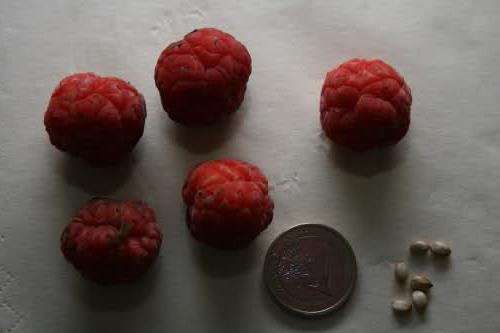

The taste and smell of the fruits of the strawberry tree, as well as their appearance, bears little resemblance to the actual strawberry itself. The presence of sugars in berries determines their sweetness, but the sourness characteristic of strawberries is completely absent. When compared with other fruits, the fruits of the strawberry tree plant, the photos of which you can see below, taste very similar to persimmon.
It is noteworthy that the fruits, like branches with leaves, contain milky juice (milk). The berries of this exotic are very juicy and soft, therefore they are not suitable for transportation. After collecting them, they are eaten for several hours, since within a day after collecting they lose their marketable and taste qualities. In addition, you can make jam or jam from kudraniya berries, dry them and use them for making drinks.
Strawberry tree at home
It is unlikely that it will be possible to grow a strawberry tree in the open ground in the Moscow region - the plant is very thermophilic, the local cold winters with sudden frosts can simply destroy the tree. But it is quite possible to sow and breed strawberries at home. It is much easier to immediately buy a seedling ready for planting, create favorable conditions for its growth and provide proper care:
- timely watering;
- periodic feeding with organic fertilizer;
- pruning small, weak shoots to form a beautiful lush crown.
How to grow curls: outdoors or indoors?
Despite the fact that in Russia there are areas with a relatively favorable climate for such an exotic plant as kudrania, cultivation in open ground is practically not carried out. Most gardeners prefer to keep this plant indoors. This is due to the requirements of this tree to the conditions of detention.
Firstly, the strawberry tree does not tolerate cold snaps, so it is quite problematic to grow it even in the southern regions. Secondly, the number of fruits on each tree is small, therefore, a rare gardener will agree to occupy the usable area of the summer cottage as exotic. Thirdly, a humid climate and the same soils are not suitable for growing curls, and it is easiest to regulate the water content both in the soil substrate and in the atmosphere when growing indoors.
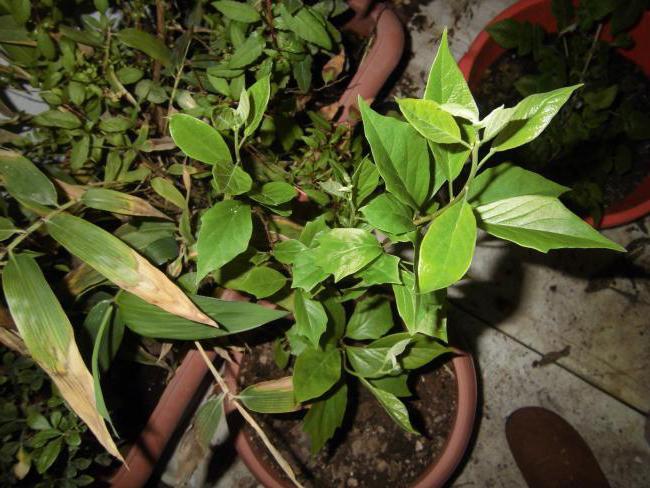

However, despite all the difficulties, the strawberry tree can be found in amateur gardens even in the middle lane. There are also enthusiasts in the Caucasus who provide the most comfortable conditions for this exotic tree.
Buy strawberry tree seeds
If you still want to grow any kind of arbutus at home from seeds, you need to know where you can buy them. You can look for shops in the city that specialize in the sale of seeds of exotic plants, but it is much easier nowadays to buy the necessary seeds in the online store. First, look at the desired plant in the photo, order and receive it in a way convenient for you. Here are some online stores where you can buy arbutus seeds:
- Becker
- a well-known online store selling elite seeds, seedlings, bulbs from the world's best breeding companies. They have a very large selection of planting material, plant protection and fertilization products. The site catalog contains more than 2000 titles. Delivery is made by mail throughout Russia. There are often lucrative promotions. - Adenium Siberia
- a large online store of exotic species of plants and seeds, which offers free advice on growing. The office is located in Novosibirsk. Provides several delivery options: by mail, by shuttle bus or by train through a guide. It is possible to pay in any convenient way: in cash upon receipt of the goods, by bank transfer from a card, or from an electronic QIWI wallet. - Dutch seeds
Is a large online seed store that operates from the Netherlands. They promise high quality planting material from well-known world breeding companies. Send orders by mail all over the world. The prices on the website are only in euros. The cost of their goods is significantly more expensive than Russian counterparts. You will have to pay 15.90 euros for delivery.
Strawberry tree price
Strawberry seeds are offered by a few Russian sites, but it is quite possible to find them. The price of a strawberry tree differs slightly from them, but if you search, you can order planting material relatively inexpensively. Here is a small table to compare the cost of Arbutus seeds in several online stores.
| Online store | Number of seeds | Cost of delivery | |
| 199 rubles | 1 package (100 gr.) | Depends on the weight of the parcel and the distance | |
| Adenium Siberia | By registered mail from 70 to 120 rubles | ||
| Dutch seeds | |||
| Super vegetable garden | 500 rubles | Not indicated | According to the tariffs of the Russian Post |
| 200 rubles | Not indicated | Depends on the amount of the order |
general characteristics
The height of an unusual exotic tree can reach 3 or even 5 meters, and some specimens even grow up to 12 m.
All varieties of the strawberry tree (or arbutus, as it is also called) have an unusual trunk shade. It is coral red, but can sometimes be brown. The branches of the tree are twisted. One of the features of the exotic plant is the annual bark change. The old bark gradually begins to fall off, and under it you can see smooth spots of a lighter shade. For this feature, the people call the strawberry "shameless". The bark peels off very unusually, during this period it begins to crack and makes a rustling sound.
The flowers of the tree are shaped like small lanterns, like lilies of the valley. They are collected in paniculate inflorescences. These flowers are white, cream or pale pink in color and have a great honey scent.
After flowering, small round fruits are formed. When ripe, they turn bright red in color. In this view, they resemble strawberries. Only in this all the similarity with the berry ends, they have nothing more in common. There are five seed pods inside the fruit. The pulp of the fruit tastes mealy, in some ways it also resembles strawberries, but it has not a sweet and sour taste, but a bitter taste.
It is known about the existence of eleven varieties of the plant, but two types of arbutus are considered the most famous and often grown:
- small-fruited strawberry, aka red (arbutus andrachne);
- large-fruited strawberry (or arbutus unedo).
The strawberry tree is valued by pharmacists, it contains many useful substances. They have gained particular popularity in cooking.
The large strawberry tree loves a fertile soil type that is rich in nutrients. In addition, it will take root faster and will grow better in sunny, unshaded areas. Watering the tree requires regular and moderate watering. It is mainly grown for decorative purposes as a houseplant.It is non-frost-resistant, therefore, when grown in open ground for the winter period, it must be transferred to closed-type premises.
In the south of Crimea, you can often see wild small-fruited strawberries. The locals nicknamed him “the resort lady”. Its taste is not as pronounced as that of arbutus unedo berries or large-fruited strawberry tree, but it is also used in cooking.
Strawberry tree - reviews
I was very interested in exotic arbutus as a houseplant. I got the idea to grow a bonsai out of it. I ordered several seeds, sowed, waited almost 2 months - nothing. I was already desperate, I even wanted to throw it away, but only now the sprouts began to appear. I love and cherish them. I really hope to grow at least one tree for myself.
I hardly found the seeds, bought it, sowed it, waited for the first shoots, but never got it. My wife laughs that I am such a gardener. It's a shame to tears! Previously, all exotics germinated without problems. What was I doing wrong? After all, he strictly followed the recommendations from a special magazine ...
I bought a small sapling right away. The whole summer the plant grew on my street, I forgot about it - it froze a little in November. Frightened, transferred to the loggia - it was gone in a couple of weeks. Continues to delight the eye with emerald leaves. I really want to wait for flowers and berries.
Still puzzling over how to increase the strawberry harvest in the country? Then we suggest paying attention to the original design idea especially for summer cottage gardening!
You no longer need to take land from cucumbers or potatoes to make another extra strawberry patch.
True, you will have to make a little more effort at the first stage than for arranging a ground bed with garden strawberries, but it's worth it!
A tree with hanging strawberry containers is as attractive as it is productive. Up to forty strawberry plants can be grown on one tree without fear of slugs and soil phytopathogens.
To create such a delicious installation, you will need:
- Dry wood
- A tool to dig a deep hole for installing a tree, and a drill
- 10 50 cm thick hanging hooks and staples and screws for securing
- 10 hanging baskets made of thick wire or galvanized metal with coconut fiber liners
- 10 metal chains for baskets
- Installation for drip irrigation, as it will be inconvenient for you to constantly water the upper basket by hand. However, the drip irrigation system can be excluded if you like to do acrobatics, and you can simplify the task of supplying plants with moisture using hydrogel balls. Placed in the soil mixture, they will accumulate water during irrigation, and then give it to the plants.
Choosing a dry tree, remove the bark and treat the trunk with moisture-repellent impregnations, at the same time get rid of insects that can live in old wood.
When choosing strawberry varieties, pay attention to remontant varieties capable of producing several harvests per season, for example, garden strawberry "Queen Elizabeth". The curly and frost-resistant Alba strawberry is a good choice.
Plant formation
To make the strawberry tree strong, beautiful and easy to harvest, gardeners shape the crown - this is the process of pruning young shoots and branches to give it a spherical or other shape. At home and in the garden, this procedure is slightly different.
In the open field
The longest shoots, or those that grow inward towards the trunk, are pruned with shears every spring. Shoots are re-examined in the summer - they are pruned again if necessary (if there is no goal to create a solid mass of branches).
Learn how to grow strawberries hydroponically.
In November, kudrania sheds leaves, and at home too, and new ones appear in March. After shedding the leaves, you do not need to prune the tree - it should sleep until spring. It is recommended to wrap the branches and trunk with natural fabric.
The most commonly used form is bonsai (a tree with a curved crown). Types of bonsai forms
This is done in the following way:
- first, part of the bark is cut off (so as not to damage the trunk), and it goes deeper into the soil. Then roots grow in the place of the cut, which are then used to form the rest of the crown;
- after the growth of new roots on the cut, the strawberry tree is transplanted into a square wide pot (for convenient processing of branches);
- now remove the three lower branches and select those that will begin to form the bonsai;
- to form the trunk, a wire is used - the trunk is wrapped around it, and a wire frame is formed under the lower branches, to which part of the branches is attached;
- this should be done carefully and gradually, day after day, gradually tilting the branches in the right direction so as not to damage the bark.
How to plant a strawberry tree
Choose the sunniest place on the site. Dig a hole 50 to 70 centimeters deep to support the weight of the post with the filled baskets.
Mark the pole for the hooks and drill holes for the screws.
Attach the hooks and place the table vertically using a spirit level. For reliability, the base can be concreted or compacted as tightly as possible.
Fill each basket with good quality soil, then plant 3-4 strawberry plants in each basket.
Hang the basket and adjust the chain.
Interesting Facts
Among the people, arbutus, which sheds its bark every year, was called "shameless". This characteristic feature is explained by the fact that trees growing in hot, humid tropical climates are attacked by plants - parasites (epiphytes), which try to settle in cracks in the bark. Therefore, the strawberry tree is freed from the bark and does not allow epiphytes to take root.
It is noteworthy that the first mention of strawberries was found in the works of the ancient Greek philosopher Theofast. Even then, people were familiar with the features and properties of this tree.
This plant serves as food for the largest Israeli butterfly Charaxes jasius. She lays eggs on it, and after a while caterpillars hatch there.
The image of the arbutus can be seen on the coat of arms of Madrid. The bronze bear by the strawberry tree is the symbol of the city. This image is present in various urban objects. According to old residents of Madrid, a whole grove of these beautiful trees was once laid out here, where one could often meet bears.
Photos of a strawberry tree, presented in the photo gallery below, convey the amazing beauty of this unusual plant.
How to care for a strawberry tree
Watering is an important part of maintenance as the soil in containers dries out quickly in summer. As mentioned above, the best option would be to install drip irrigation systems.
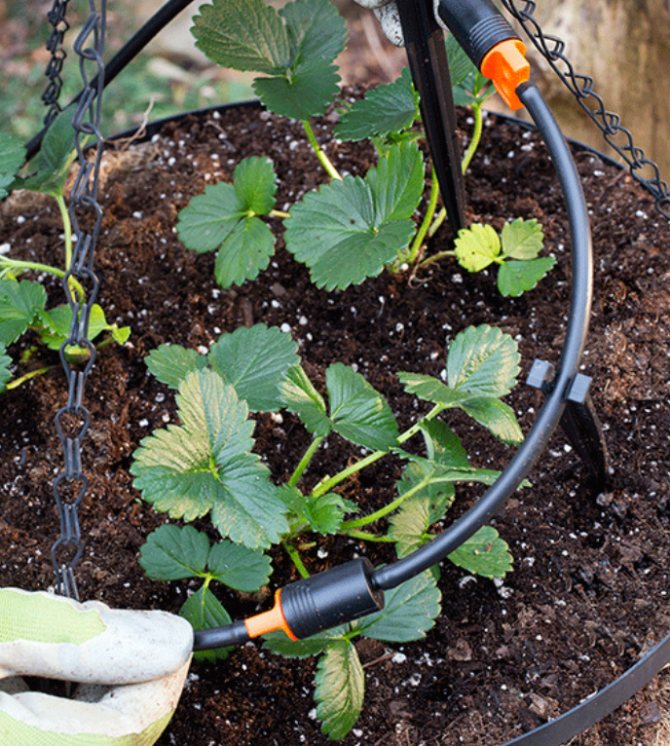

If you prefer to water by hand, only do so on the outer circle of soil in each basket where the air circulation is greatest. This will prevent root rot, to which strawberries are sensitive when over-watered, and will also help protect the foliage of the garden strawberry from moisture and the development of diseases.
Be sure to carry out regular liquid feeding to provide the plants with the necessary amount of nutrients for the production of large, beautiful and juicy berries.
Remove shoots and dry foliage and keep birds out of the berries. Feathered, especially starlings, love to feast on fresh strawberries, especially when you so kindly hung the baskets of plants higher. To scare away birds, you can decorate the tree with "pendants" from old discs that glare in the sun, or leave a branch under a funny stuffed animal. Alternatively, apply a humane repellent to the top of the barrel. Thus, you will ward off the birds not only from the berries growing on the structure, but also drive them away from the garden without causing harm.
Pick berries on time, do not let the fruit rot.
Each new season should begin with disinfecting the baskets and filling them with a new soil mixture, since over the summer the plants will use up the entire supply of nutrients in the soil, which can also become a place for the accumulation of phytopathogens.
(Idea for strawberry tree and photo by Van Chaplin).
Curl planting material: how to get it?
So where to start growing curls? Of course, from the planting material. You can buy it in specialized stores or from amateurs. If you yourself are the happy owner of curl, you can try to propagate it yourself. This can be done in several ways: cuttings, root shoots or seeds.
It should be noted right away that the best way to get planting material among those who are engaged in growing curls is to separate the root growth. In this case, you can get up to 99% of viable seedlings, which, moreover, enter fruiting earlier.
Cutting a strawberry tree plant, reviews of which in this regard cannot be called positive, is a rather complicated process. To begin with, cut off annual shoots without signs of disease are placed in a solution of root formation stimulants for 16-18 hours. After that, the cuttings are placed in a sandy moistened substrate for 3-4 months. In this case, it is important to constantly monitor the moisture content of the soil, not allowing it to dry out completely.
The chance of getting a healthy young plant in this way does not exceed 30%, so cuttings are not very popular. In addition, after transplanting cuttings with formed roots, there is a high probability of their death, so when planting them in containers, do not forget to use any stimulant.
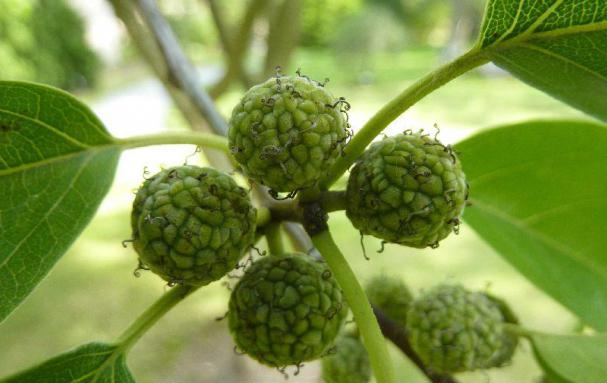

There is no reliable information about the reproduction of curl seeds by seeds, however, it is known that the plants obtained in this way begin to bear fruit only 10-15 years after germination.
Frost resistant
Frosts of kudraniya do not tolerate well: at high subzero temperatures, the root system of a strawberry tree dies - both a young and a perennial plant can disappear. Indoor curls are transferred to a room during the winter, placed on the sunny side and constantly sprayed to avoid drying out the leaves.
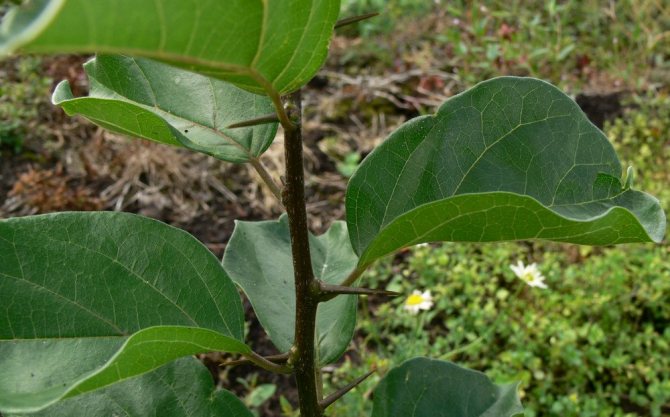

Street trees are wrapped tightly in homespun, dried needles or straw are poured onto the roots, the surface near the roots is sometimes even covered with oilcloth, and on top again with cloth.
Strawberry tree: biological features and habitat
Arbutus, strawberry tree or strawberry is an evergreen plant from the Heather family, which is a short tree or short shrub.
The strawberry usually reaches a height of 3-5 meters, which may take up to 50 years, but some species grow up to 12 meters. The trunk of arbutus is covered with smooth orange, reddish or brown bark, in some species (small-fruited strawberry) it changes annually, while the plant makes a rustling sound.
Strawberry fruits are rounded drupes no more than 3 cm in diameter, covered with small growths. Inside the berries there is a mealy sweet and sour pulp with a large number of small seeds. The fruits resemble strawberries in appearance and smell, they taste like an exotic fruit, have a characteristic bitterness due to the presence of tannin.
In the wild, the plant is found in America, Mexico, the Mediterranean, Western Europe, Tyrol, where it grows on hills and rocky slopes, and in culture, the strawberry tree can be seen on European streets and parks.
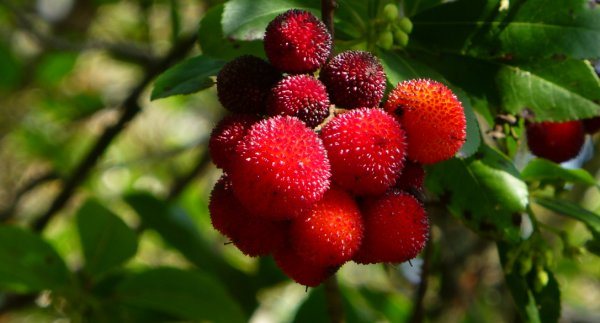

There are 11 plant species in total. Usually in the general description of the strawberry tree and the description in the scientific literature, the large-fruited arbutus is meant.
Did you know? The coat of arms of Madrid looks like a shield topped with a golden crown with an azure border, inside which is depicted a bear and a strawberry tree. The coat of arms acquired its modern look in 1997. In the center of Madrid, in Puerta del Sol, there is a monument to a bear eating fruits from a strawberry tree.
3. Varieties:
3.1. Arbutus tree large-fruited - Arbutus unedo
A profusely branched evergreen shrub with glossy, dark green leaves and smooth, slightly flaky brown bark. The flowers are white and cover the plant abundantly during the flowering period. The fruits are round, bright, edible.
↑ Up,
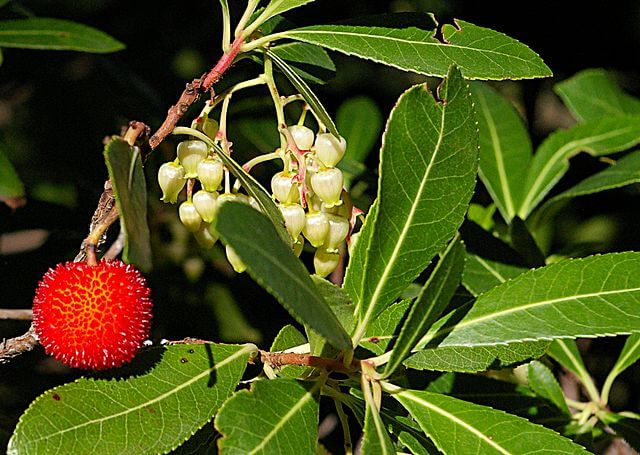

Strawberry: calorie content and chemical composition
The strawberry flower has a pleasant and light honey aroma. Use it as a diaphoretic. The plant also has excellent antiseptic properties, so it is recommended to take various decoctions, tinctures and medicines based on strawberry for sore throat and pain in the genitourinary system. The bark and leaves of strawberry contain substances that are useful for the digestive system. They have anti-inflammatory and soothing properties.
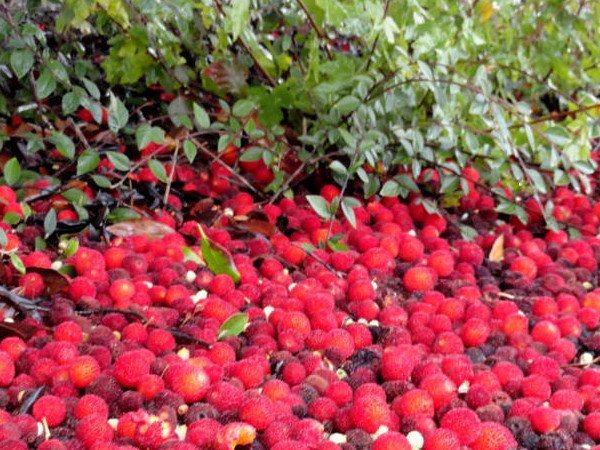

The chemical characteristics of arbutus are still being studied. Still the fruits are rich vitamin B, malic and ascorbic acid, sugar and pectins.
Overripe fruits contain a percentage of alcohol. The bark also contains tannin, which gives a bitter taste, tannins, flavonoids. By the way, strawberries are food for large butterflies that inhabit Israel, and honey is created from the fruit of the tree, which has a tart taste and pleasant aroma.
Souvenir boxes and watch cases are even made from durable strawberry wood. As for the caloric content of the fruit of the tree, the energy value is 28 kcal: of which proteins - 0.8 g; fats - 0.4 g; carbohydrates - 7.5 g.
The plant has several more names: a health resort girl, a whisper and other original "names". Since the plant loves warmth, it is best to grow it in a winter garden, in greenhouses, in greenhouses.
In the greenhouse, you can also grow plants such as cucumbers, tomatoes, strawberries, bell peppers, eggplants, and radishes.
Application in traditional medicine
Traditional healers use all parts of the strawberry tree. Raw materials are collected in summer, dried under a canopy or on pallets of dryers, turning over every day. Dried arbutus gifts are stored in paper bags for no more than 2 years. Homeopaths use raw materials for inflammation of the bladder and urethra, skin diseases, accompanied by itching and the appearance of blisters, abscesses, scales, problems of the digestive tract.
Decoctions and tinctures are used for diseases of the ears, throat and nose, lesions of the oral mucosa.
The plant extract is used as a means that reduces the tone and motor activity of smooth muscles, relieves inflammation and increases the rate of urine formation.
Pharmacological properties
The chemical composition of arbutus is poorly understood. It is known that the fruits of the plant contain organic acids, polysaccharides, sugars. Overripe fruits contain 0.5% alcohol. The bark and leaves contain polyphenols, tannins, and the toxic glycoside Rhodotoxin.
Medical use
For a long time, the extract from the plant has been used as a cure for acutely infectious epidemic diseases. Arbutus has properties to prevent decomposition processes on the surface of open wounds, to increase the rate of urine formation. The infusion of culture leaves relieves involuntary contractions of the stomach muscles, restores the physiological functions of the intestines. A decoction is applied externally, applying bandages to damaged skin areas, burns.
Contraindications
Treatment with drugs based on arbutus is contraindicated for pregnant and lactating women, children. An overabundance of plant berries can provoke migraines, indigestion.
Photo gallery
Pests and diseases of curl and methods of dealing with them
No matter how sissy the tree we are considering may seem, few plants can compare with it in terms of resistance to pests and diseases. This exotic beauty is not affected even by such "eminent" pests as spider mites and aphids. However, if agricultural technology is not followed, the strawberry tree can be attacked by thrips and mealybugs. Normalization of humidity and temperature in the room helps to cope with them, as well as special preparations that can be purchased at any store for gardeners and florists.
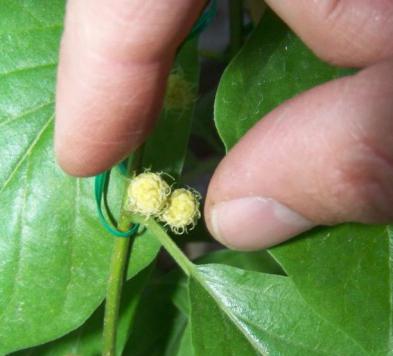

Using
The pollen of the flowers of the strawberry tree is processed by bees into bitter honey. Wine and aromatic vodka are prepared from berries, jam, candied fruits, syrups are made. They are eaten fresh, but in small doses. But this does not apply to strawberries, which are grown in an apartment. Rather, it performs a decorative function.
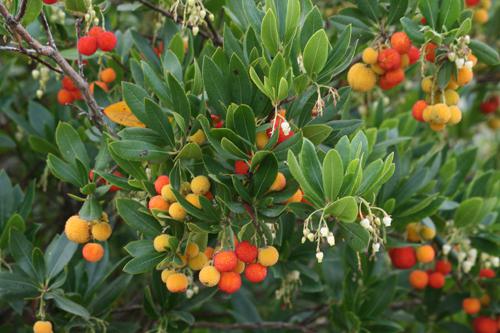

Extract from plant parts is used for processing and dyeing leather. It contains a substance called tannin, which not only imparts astringency to the leaves, but also repels animals that try to eat the stems of the plant.
In medicine, they are used to treat diseases of the urinary system and to protect against microbes.
The wood is off-white and does not rot. It is highly valued and is used to make gift boxes.
An interesting feature of strawberry wood: it does not lend itself well to fire. Therefore, the strawberry tree is used in growing areas for reforestation after a fire.
The calorie content of the fruit is about 30 kcal. But there is evidence that, when consumed in large quantities, they act like a dope. They have a severe headache. Unripe fruits cause nausea and vomiting.
Seed stratification and preparation
It is not difficult to grow a strawberry tree at home. To do this, before sowing, the planting material is stratified for about two months in a special mixture consisting of:
- peat - 70%;
- sand - 30%.
Then, dry seeds are placed in a container with warm water and left for a week.
For stratification, the planting material is placed in the prepared mixture to a depth of 10-15 cm and watered well. The container is covered with a bag and placed in the refrigerator for 3 months (but not in the freezer). If there is a glazed balcony or loggia, you can take out a container with seedlings there too. Sometimes the seeds can begin to germinate already in the refrigerator. In this case, the container is placed on a window on the north side (so that there is no direct sunlight and so that it is warm, but not hot).
If the seeds have not sprouted after 3 months, they are taken out of the refrigerator and placed on the same north window, but the bags are not removed.
Did you know? The strawberry has its own peculiarity - the plant sheds its bark every year. She falls with a bizarre rustling, for which the tree was nicknamed "the whisper."
Types and varieties
Greek strawberry or red
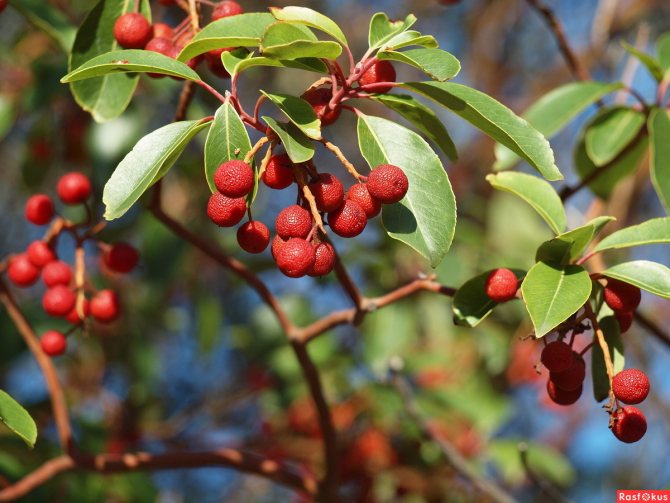

Greek strawberry (small-fruited)
Greek strawberry (small-fruited) grows up to 5 meters high. The bark is smooth, fragile, begins to flake off in summer. The bark changes color: initially turquoise, then lemon and by the end of summer crimson. Leaves are oval, up to 10 cm long. The flowers are tiny. Orange-colored fruits. Blooms from December. Russian flower growers have been growing this species since 1813.
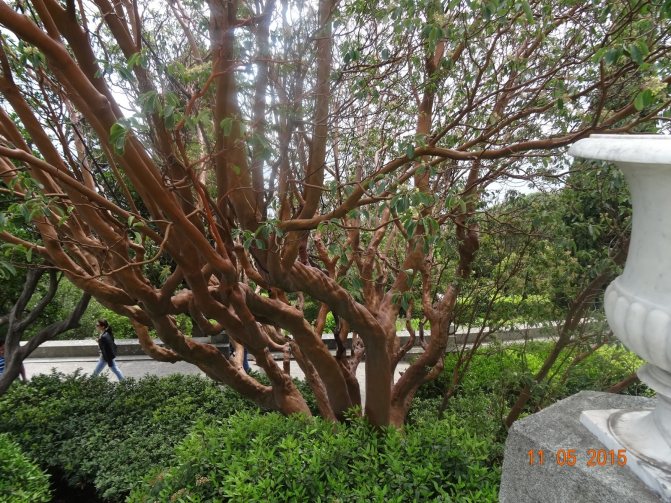

Greek strawberry (small-fruited)
Arbutus Menzisa
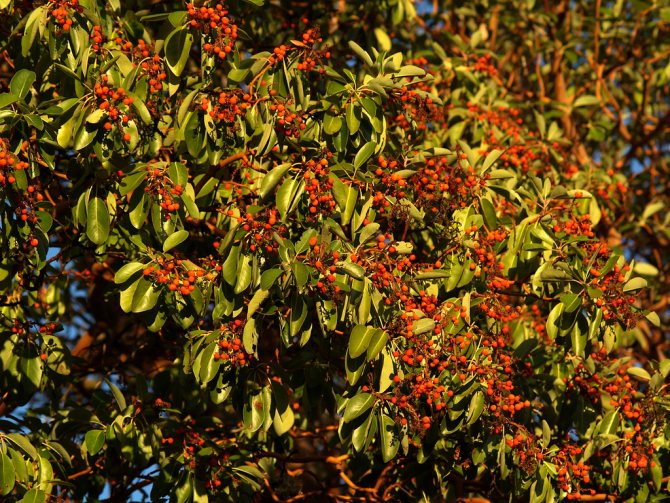

Arbutus Menzisa
Arbutus Menzisa is a plant up to 25 m high. The bark is red-brown. Inflorescences - brushes, fruits of carrot-scarlet color. Blossoms in spring, fruits ripen in autumn. Loved by flower growers since 1827.
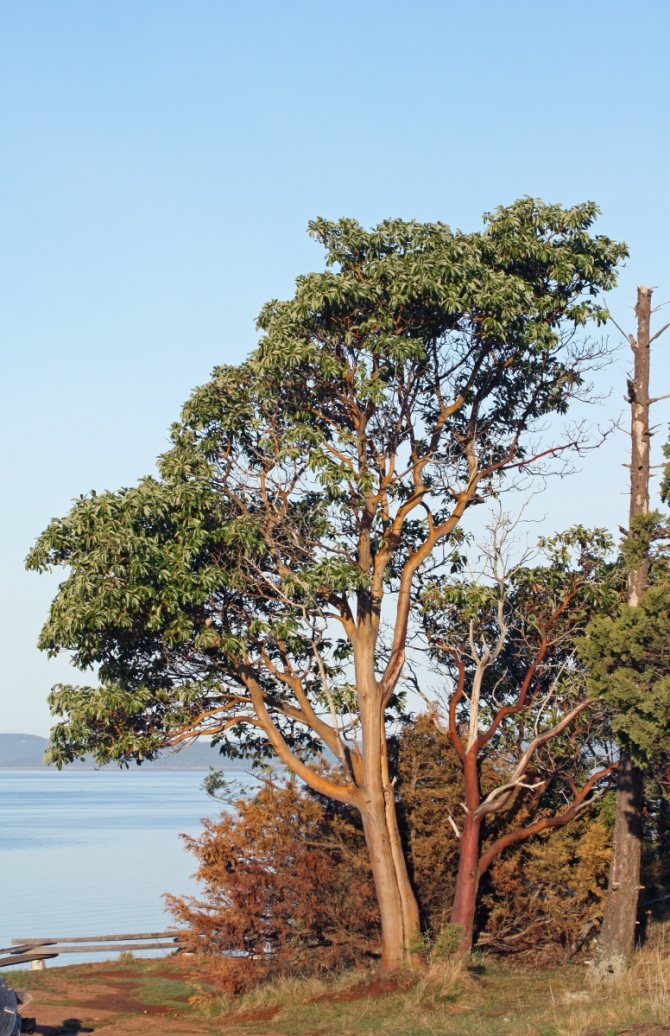

Arbutus Menzisa
Arbutus ordinary
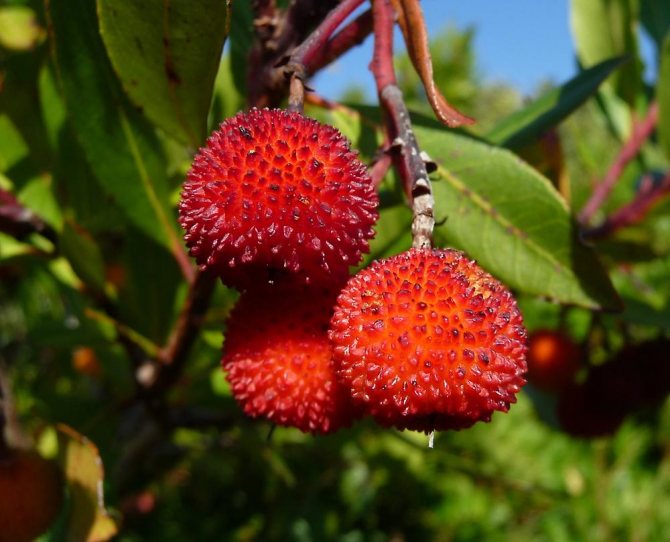

Arbutus ordinary
Arbutus ordinary or large-fruited strawberry tree is the most common species. The bark is brown, uneven. The inflorescences are short, the flowers are snow-white or creamy pink. Scarlet berries up to 2 cm in diameter. The species is able to grow on seemingly unsuitable soils.
Arbutus hybrid "Marina"
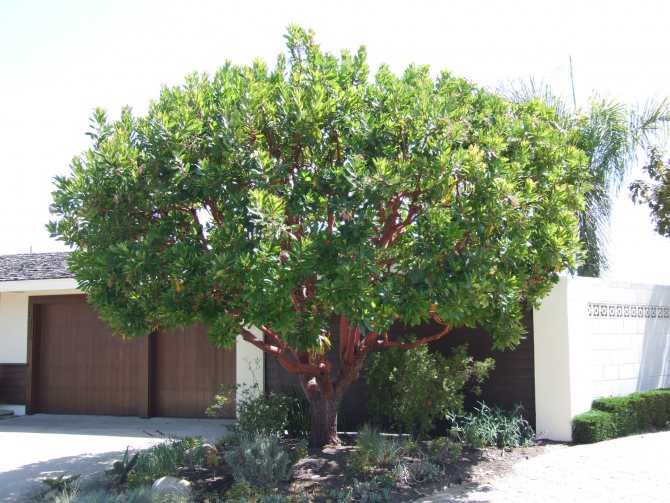

Arbutus hybrid "Marina"
Arbutus "Marina" hybrid is suitable for growing in garden plots. The origin of the hybrid is unknown. Plants of this species stand out for their smoother stem and branches.
Choosing a landing site
Kudrania prefers well-lit, warm places. In a shaded area, the plant will not develop. If the plant is grown indoors, then the flowerpot must be placed on the sill of the south window. Groundwater should not come close to the soil surface. This tree does not tolerate excessive moisture in the air and soil.
The soil is required fertile, with high permeability to water and air. Low or zero acidity is preferred. Loamy soil is the best option.
For planting in a garden or in a flowerpot, it is advisable to prepare a soil mixture from turf, humus, peat and sand, combined in a ratio of 2: 1: 1: 1.
Origin and species of kudraniya
It is known that the strawberry tree originally grew in East Asia, Afghanistan, Iran, and also in Central China. By species, kudrania belongs to the Mulberry family by biologists. This is what determined the exactingness of this exotic to the temperature of the soil and the environment, illumination and humidity. How did this plant get to other territories and when did it happen? Kudrania, a photo of which is now not uncommon, was allegedly spread almost all over the world thanks to trade and tourism development. Be that as it may, but even in the last century, only botanists knew about this plant, and today this tree is in the collection of any self-respecting amateur plant breeder.
Outcomes
For the successful cultivation of a strawberry tree and obtaining a high-quality berry harvest, special attention should be paid to the main points:
- Find the desired planting site in the garden.
- Prepare the required potting mix.
- Land according to the recommendations.
- Water, feed and prune the tree in a timely manner.
- Loosen and mulch the root zone, remove weeds.
- Take timely pest control measures.
- Cover trees for the winter.
Decorative application
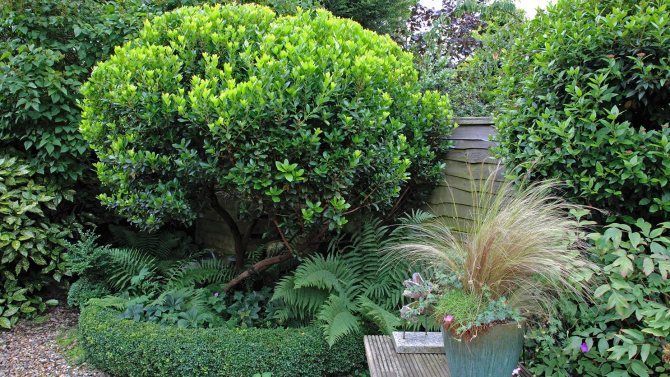

When they talk about trees and shrubs for the garden, plants such as lilacs, forsythia, magnolia spontaneously come to everyone's mind, forgetting about the handsome strawberry. The tree is perfect for growing in gardens, squares, where it will look very picturesque. Luxurious branches, bright flowering, delicious fruits - all this cannot but rejoice and attract the attention of nature lovers. Arbutus will decorate a winter garden or living room for many years, you can admire it at any time of the year. A strawberry tree in a home greenhouse is a jewel and luxury, it must be protected and looked after.
Botanical name: Strawberry tree, or Strawberry, or Arbutus. Genus Strawberry tree, Heather family.
Homeland of the strawberry tree: America, Western Europe.
Lighting: light-requiring.
The soil: fertile, nutritious, drained.
Watering: moderate.
Maximum height: 5 m.
Average life expectancy: over 100 years.
Landing: seeds.
Description of the plant
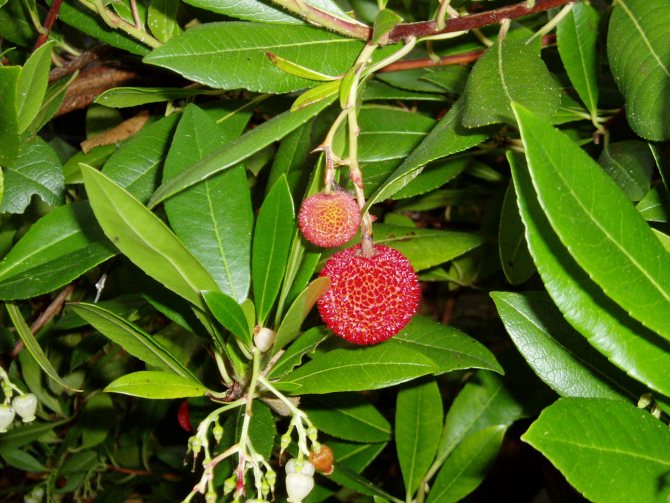

The leaves of the strawberry tree are large, wide, petiolate, with a well-developed system of conductive veins, with small notches along the edges. The flowers are collected in panicles, snow-white or straw-colored, shaped like lanterns. Seeds are ovoid, tiny. The fruit is spherical, with many seeds, the flesh is loose, the taste is reminiscent of strawberries. Ripe berries are orange-red in color, up to 3 cm in size. The tree grows extremely slowly, the height of a fifty-year-old representative is about five meters. Blooms in autumn. Arbutus can bear fruit for over two hundred years.


The strawberry tree has a rare feature - the ability to change the bark every year. Arbutus ordinary beautiful honey plant, honey is obtained with a spicy bitter taste.Arbutus wood is not destroyed, does not decompose. Previously, it was used to create chic caskets, chests, and various products, and modern craftsmen use the extract from the bark in the production of brown dyes.


Botanical description
Strawberry tree is a shrub or tree up to 15 m high. The bark is uneven, copper-brown in color. Leaves are ovoid, emerald green, shiny, up to 10 cm long, leathery. Inflorescences are paniculate, about 5 cm long. The calyx resembles a saucer, five sepals, an ovoid corolla, up to 1 cm long, narrower under the bend, snow-white or pink. The fruit is a spherical red drupe with many seeds.
Persimmon multicolored
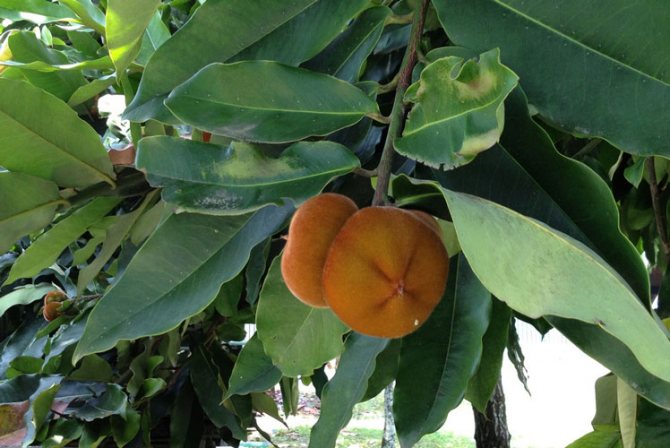

wikimedia.org
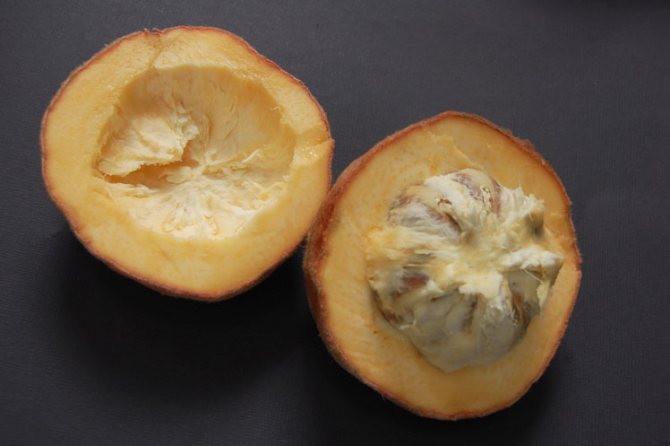

wikipedia.org
Persimmon multicolored (also Persimmon Blanco or Mabolo) is an evergreen slow-growing tree with a height of 18–33 meters. Mabolo's homeland is the Philippines. It is currently also cultivated in Indonesia, Malaysia and the Antilles (Cuba, Jamaica, Puerto Rico, Trinidad).
The fruits of persimmons are multi-colored, oval or flattened, 5–10 cm wide. The peel is pink, brownish, yellow, orange or purple-red in color with a velvety surface, covered with a hard cup at the base. On a tree, fruits often grow in pairs. The peel of the whole fruit exudes a sharp, unpleasant, cheese-like odor.
The pulp is whitish, strong, powdery, moist, but not juicy, with a mild sweet apple-banana aroma. Seeds are brown wedge-shaped, covered with whitish membranes, 4 cm long and 2.5 cm wide, located around the central core in an amount of 4-8 pieces. Seedless fruits are sometimes found.
On the surface of the fruit, there are small hairs that can severely irritate the skin and mucous membrane of the human mouth. Why the plant is known under the name "Velvet Apple" or "Velvet Persimmon". Remove the skin from the fruit before use.
Planting and breeding
The plant is propagated by seeds and apical cuttings, often flower growers buy a ready-made arbutus seedling.
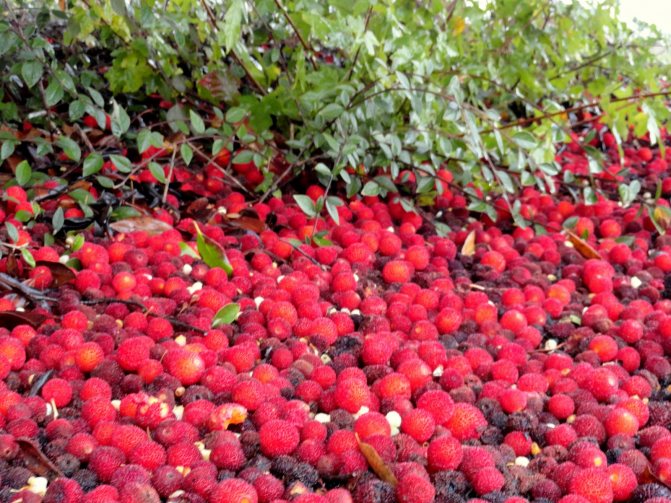

Transplant rules at home
The root system is very fragile, so transplanting is extremely poor. Young representatives of strawberries are transplanted every two years, and older ones as the root system grows. It is better to replant in the spring, before the formation of new shoots. It is important not to damage the root system. Systematic fertilization contributes to the development of the plant and eliminates the need for replanting for a long time.
Reproduction
They practice 2 methods of propagation: by seeds and apical cuttings. When using the second method, at the end of summer, cuttings are cut and stored warm. They are planted in the ground in spring when the risk of frost is minimal. It is difficult to propagate by cuttings, the rooting process takes time and effort, and does not always end with success.
Curl care in the first year after planting
In the first year after planting, the strawberry tree does not need additional fertilizing (provided that a nutritious soil mixture has been compiled). Otherwise, fertilizing with a solution of universal fertilizers may be required. In addition, it is important to start forming the crown of the tree and not forget to monitor its condition. Despite the relatively high resistance to diseases and pests, it is worth paying attention to the condition of the stems and leaves of the plant. When traces of pest activity appear, it is important to start treating the tree with suitable means.
Landing
- Pits 50 * 50 * 50 cm in size are prepared. A layer of drainage material 30 cm thick is laid out on the bottom. These can be small fragments of broken brick or expanded clay.
- If planting is done in a flowerpot, then a 3 cm thick drainage layer is poured on its bottom.
- Part of the soil mixture is poured onto the drainage layer in the form of a mound. Place the seedling in the center of the hole and spread the roots.
- The roots of the seedling are covered with the rest of the soil mixture, lightly tamping the soil so that there are no voids left.
- Water the seedling with a bucket of water, and mulch the root zone.

